MS Stockholm
1948 History and her future incarnations to 2019
Please
Note: Firefox and some iPad’s or iPhone’s, etc are not suitable
Use Google Chrome for this page to load perfectly!

Click the logo above to reach the ssMaritime FrontPage for News
Updates & “Ship of the Month”
With
Reuben Goossens
Maritime
Historian, Cruise‘n’Ship Reviewer, Author & Maritime Lecturer
Please Note:
All ssMaritime and other related maritime/cruise sites are 100% non-commercial
and privately owned. Be assured that I am NOT associated with any shipping or
cruise companies or any travel/cruise agencies or any other organisations!
Although the author has been in the passenger shipping industry since 1960,
although is now retired but having completed over 700 Classic Liners and
Cargo-Passengers Ships features I trust these will continue to provide classic
ship enthusiasts the information the are seeking, but above all a great deal of
pleasure!
Swedish America
Line
“Rederie
Sverige Nordamerika”
MS
Stockholm IV
Delivered
in 1948 & Still Sailing!
Later
to become: MS Völkerfreundschaft, Volker, Fridtjof Nansen, Italia I,
MV
Italia Prima, Vultur Prima, Caribe,
Athena and Azores
still sailing 70 years after her
delivery, currently named … MV Astoria
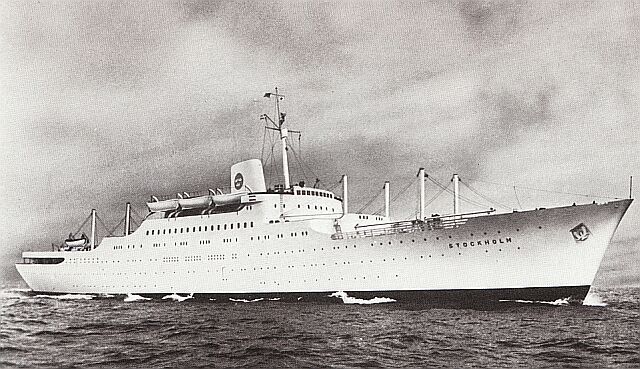
The
delightful yacht-like MS Stockholm seen as built in 1948
Please
Note: Photographs are from the Author’s
private collection,
or as mentioned otherwise
Introduction: Although this feature is all about the remarkable and enduring Rederie Sverige Nordamerika liner MS Stockholm IV, you will note that I
have also included mentions and some images of her earlier namesakes, As well
as other SAL ships during her days with the company before the MS Stockholm IV
was sold in 1959. I trust that this feature will make interesting reading,
considering that a good 64 years after her being delivered to her owners she is
still sailing and better still she is in better shape today than most modern
ships, as she is not only spotless, but her standard of maintenance is better
than I have found on most modern cruise chips, in fact she puts all of them to
shame!
I enjoyed two cruises on her as MV Athena as
she is was then named, from Australia to Portsmouth, U.K., for 39 and 40
nights, in 2011 and 2012, and these voyages were so good that I had rebooked
another for November 2012 from Marseilles, France back to Australia, but sadly
an amazing man the owner of “Classic Cruises International” Mr.
George P. Potamianos, one of the world’s most respected passenger and
cruise ship owner’s and operator suddenly passed away on May 29, 2012,
whilst I was aboard the wonderful Athena on the way to Portsmouth! His two sons
took over, but they rapidly sent the company into liquidation. But let us now
go back to the early days of the company, and go right through, where the MS
Stockholm is today, for as of 20018, she is indeed still sailing, and will be
in 2019 as well! That is an amazing an amazing 71 years after she commenced
service as the Stockholm in 1948, making her the oldest motor passenger ship in
continued operation!
Reuben Goossens.
Maritime Historian, Author
& Maritime Lecturer.
Commenced
in the passenger shipping industry in May 1960.
Brief Introduction:
“Rederie Sverige Nordamerika” became known as the “Swedish
American Line” in 1924 or “SAL” as they became
lovingly known, but this great company was originally founded by Mr. Wilhelm R.
Lundgren who saw an opening for a Swedish shipping line as the country had
witnessed a vast number of migrants heading for North
America.
SAL’s First Liner - SS Stockholm I:
Then
in 1915 SAL decided to officially establish a Trans-Atlantic service and thus
they obtained the fifteen-year old Holland-America Line, Harland & Wolff
built liner, the SS Potsdam and they renamed her Stockholm.
Thus she would be the first of a series of ships that would bear this name.
The 12,600-ton SS Stockholm departed for SAL’s first voyage from Gothenburg to New
York
on December 11, 1915 and commenced a new reputable Trans-Atlantic service for
the company setting new standards in ocean travel.
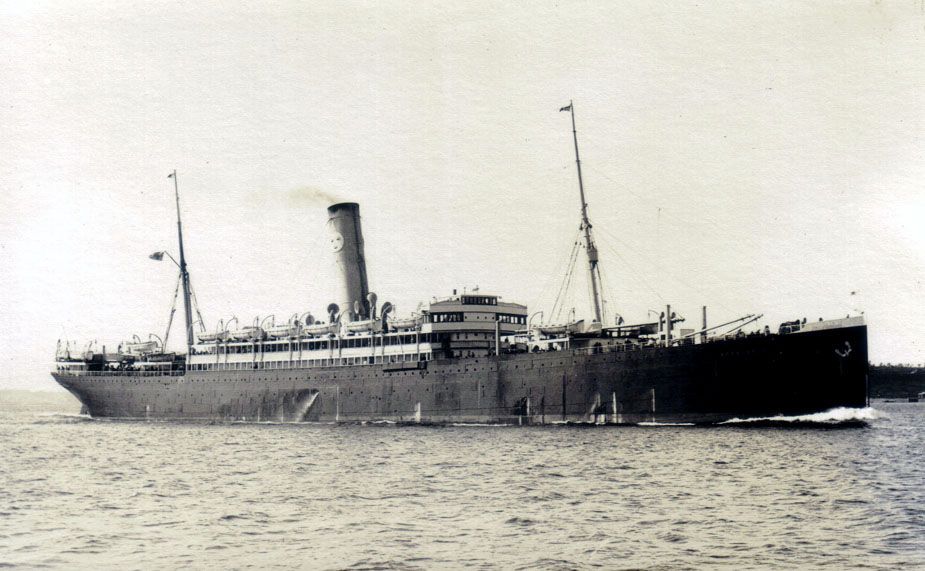
Postcard
of the ex HAL Potsdam, Stockholm
I
- seen in her early days with SAL
Author’s
private collection
In
1922 she was converted for oil firing by Gotawerken
whilst at the same time her funnel was shortened and she received a good number
of other refurbishments making her an even better ship than before!
Two New Liners:
However,
very soon SAL decided to build several new liners on a more grand luxury style,
the first was the superb MS Gripsholm in 1925,
followed by the mighty MS Kungsholm in 1928. Both
ships set new standards at sea with their super luxurious interiors making SAL
a popular line with the Americans!
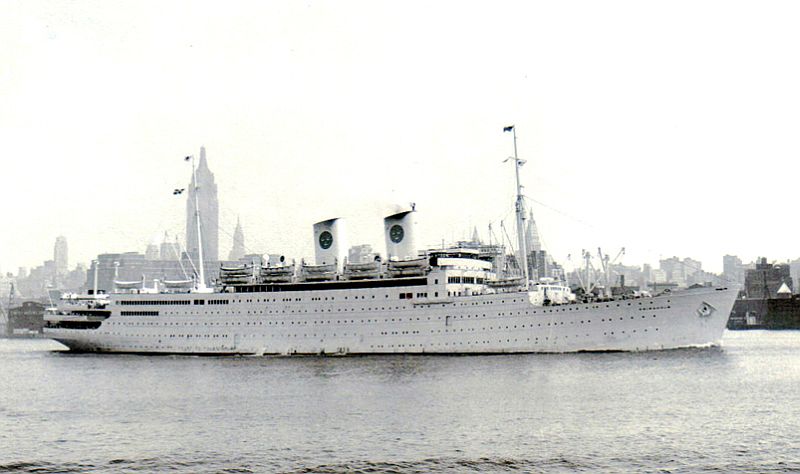
MS
Gripsholm is seen here in 1950
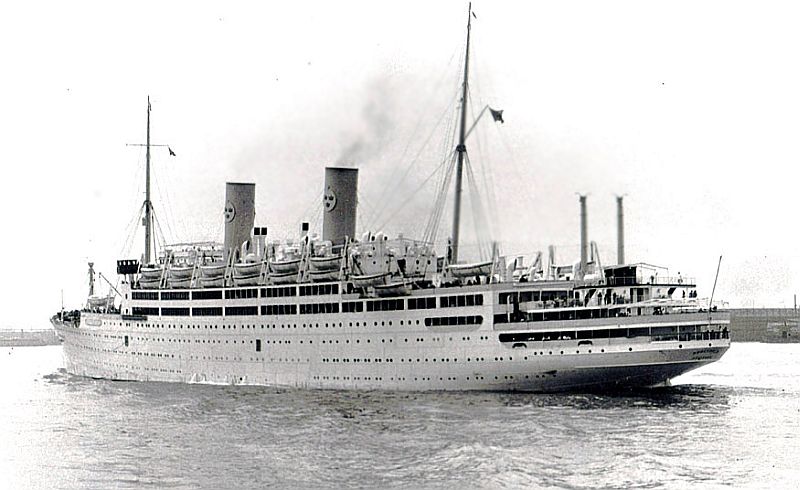
MS
Kungsholm seen here in 1931
However,
by the time the Gripsholm set sail in 1925, with the
changes that had set in, the migrant trade had sadly dropped significantly and
therefore SAL had to look for new markets and they soon realized that there was
an excellent market available to them transporting Swedish and other
Scandinavian families to visit their relatives in North America, as well as
bringing those who had migrated to the USA
back home for a visit.
But then there was that other market that had
been gaining great popularity in the United States and that was holiday cruises
to the warmer climes, thus SAL decided to add regular series of cruises from
New York during the winter season when the weather on the Atlantic was too bad
and the Caribbean was just warm and perfect for a vacation!
At first one of their ships would operate
Trans Atlantic services during the summer months and cruises during the winter
months. These new services became so successful and popular that soon it became
two ships operating the cruise service. Having entered the cruise services, SAL
found themselves once again a financial success, something just operating on
the Atlantic
could never produce!!
But, like everything, all too soon trouble
struck again as WWII would end SAL prosperity for their liners like ships of
all other companies and nations had to enter the war duties as required, mostly
as troopers or hospital ships.
The
Stockholm
II:
However,
before to the war, in the mid thirties SAL decided to replace the old Stockholm
and build a new and a much grander ship and thus they ordered the 28,000 GRT Stockholm II to be
built by “CR Dell’ Adriatico Shipyards” at Monfalcone, Italy.
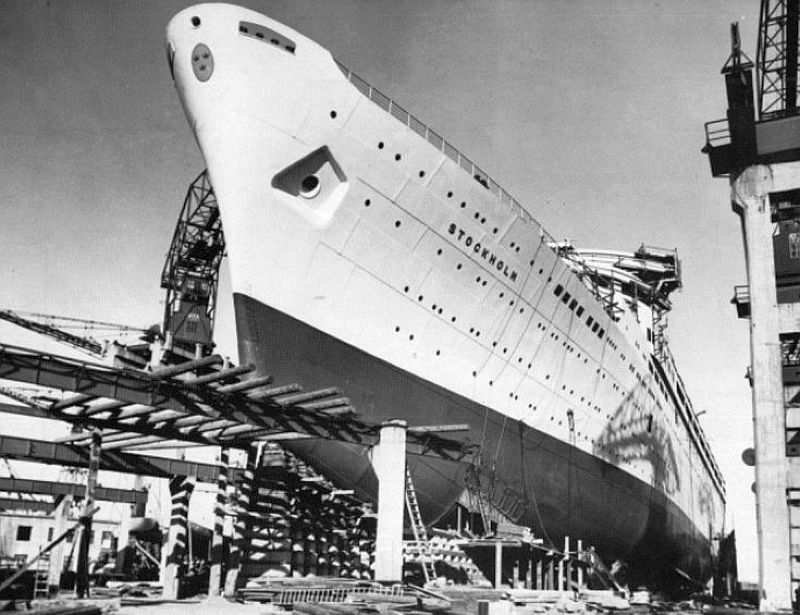
MS
Stockholm II seen prior to her being launched
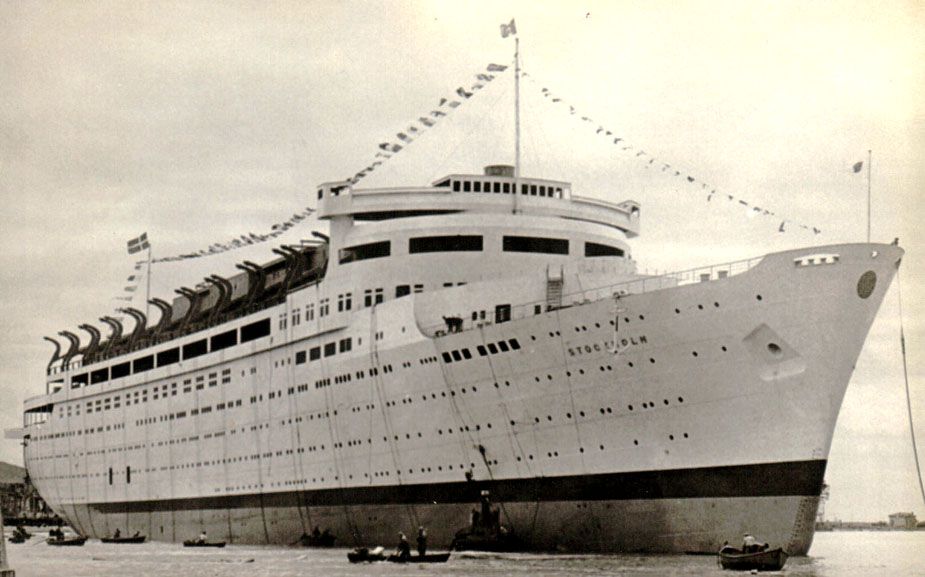
Stockholm
II seen having been launched-
Note her mast forward of the Bridge
The
Stockholm II was launched on May 28, 1938, however
close to her completion on December 19, the liner caught fire due to an
electrical fault and she was completely burned out and gutted, and she was
declared a total wreck. Sadly it was decided to have this superb ship scrapped.
MS Stockholm III:
MS
Stockholm III was started immediately after the destruction of Stockholm II and
she was launched on March 10, 1940. She was 29,307
tons, 675 ft long x 83.3 ft wide, a motor ship with triple-screws, a capacity
for 1,350 passengers in three classes.
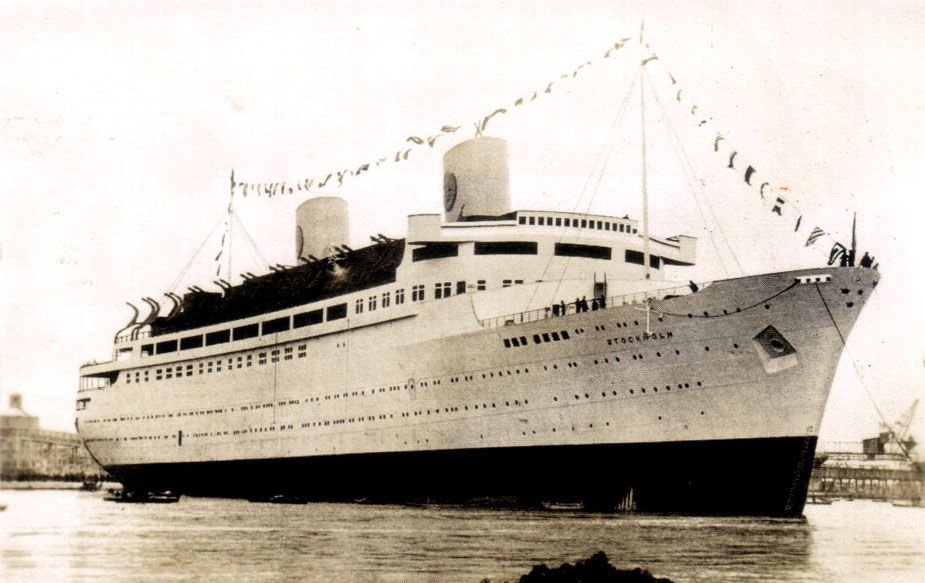
MS
Stockholm III seen at her launching – She was almost identical to her
forerunner, but there were differences
Including,
this ship having a full mast forward
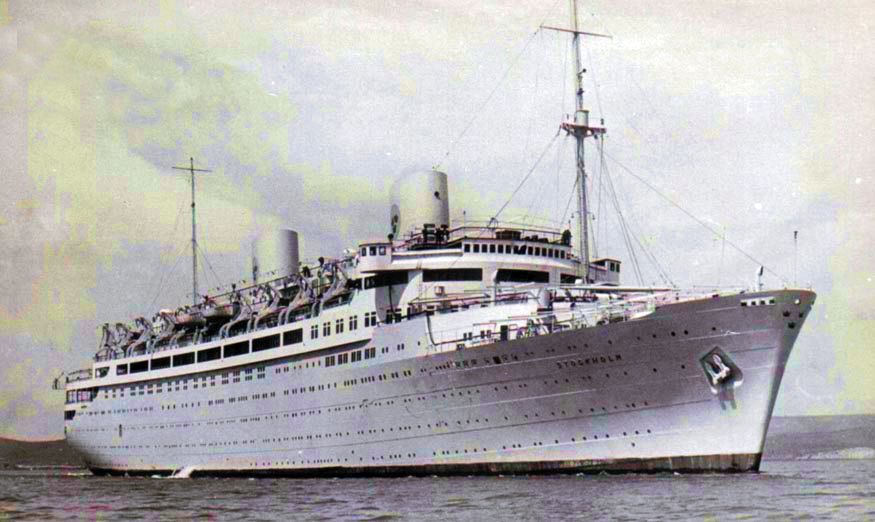
Above
& below MS Stockholm III seen during her sea trails in October 1941
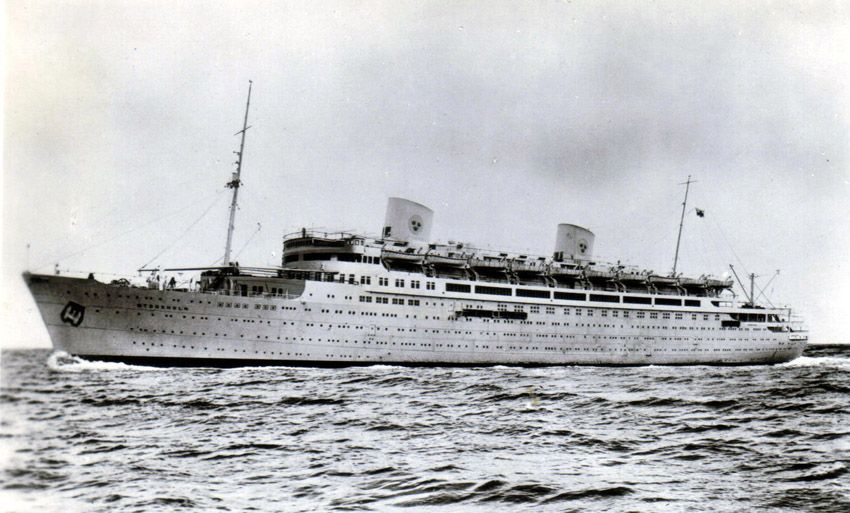
She
was completed in October of 1941. However, with the extended delays and a war
now in full swing, SAL decided against taking delivery of the liner, and as the
Italians were extremely short of ships thus the Italians were happy to take her
and renamed her MS Sabaudia. She entered the Italian
service as a troop ship. However sadly in July 1944
she was hit during a British air raid at Trieste
and the Sabaudia
caught fire and duly sank.
The Most Enduring Passenger Liner – The MS Stockholm IV:

Here
we see the beautifully designed and sleek yacht-like MS Stockholm as built in
1948
Please
Note: When I first wrote MS Stockholm’s
history I was unable to state, that certain information contained herein was
obtained from one of the SAL’s ex executives
but for reason’s of his own he did not wish to be known, although sadly
he has now passed away and I will still not name him. However, I am more than
grateful to this wonderful man for I am well aware that he had great visions
for his company, although he certainly did not always agree with all the
decisions that were made. Therefore details below are as we say “from the
horses’ mouth” and are thus 100% correct, even though I have been
challenged in the past on certain issues, but be assured all contained herein
have been verified!
Reuben Goossens.
With World War II finally
over, SAL was in great need of a new Trans-Atlantic liner for their Gothenburg
to New
York
service. However they now faced a new set of problems in relation to the design
and size of the ship SAL required. The first idea was to follow their previous
model and build a
ship of a similar size and one of grand style, sized
around the 28,000 ton mark and ensure that her interiors would be of a grand
style which was let’s face it the benchmark of the Swedish America Line.
However, the many of the executives felt that
a new direction should be thought about and that a more modern and a smaller
ship should be considered at that time. The main reason for this being the ever
growing popularity of air travel, which had seen a huge decline in ocean travel
and thus the executives thought it wiser to build a smaller and a more intimate
ship that offered a more smart casual atmosphere that would be more suitable
and able to cater to all age groups. In spite of these decisions believe me
there were many objections from certain executives both in Sweden,
but more so in the American side of the Atlantic.
However after considerations SAL in Sweden
“stuck to their guns” and decided that a smaller ship would best
cover their needs at that time and went ahead with the super sleek design of
their choice!
In October 1944 the task of
building their new liner was given to the “Gotawerken
shipyards” in Gothenburg and her keel was laid down April 1945 in Yard
611. But, no sooner had building commenced a number of ongoing problems seemed
to follow her. Due to a number of strikes, the laying of her keel had been
delayed for some two months. Problems continued right up to the moment when she
was to be launched on September 9, 1946. For some reason it took a long time,
and great deal of trouble before she was able to start her journey down the
slipway towards the water. It was said that it was “a bad omen.” In
relation to that last statement; to be quite frank, this wonderful ship is
still afloat and sailing to this day in 2014 and she is in superb condition, I
have personally sailed on a number of times. Thus as she is still sailing, I
would call her a very lucky ship and certainly not a ship that was supposed to
commenced her life with a “bad omen”. But more on her current days
later!
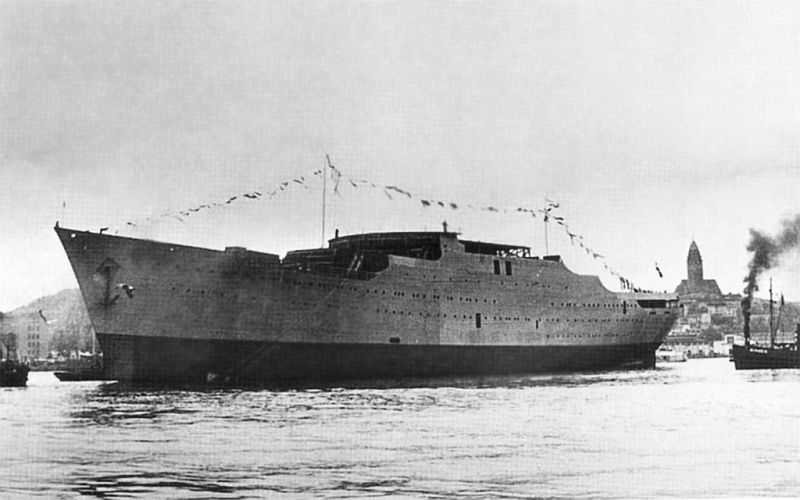
On
September 9, 1946 we finally see the long awaited new MS Stockholm IV in the
water
MS Stockholm IV was delivered to SAL
on February 7, 1948, and it was obvious to all who saw her that she was very a
different ship to all previous SAL ships. The Swedish America Line ships had
established a reputation of grandiose decorations and spacious passenger
accommodations, whilst the new Stockholm was, due to her size, rather intimate
and she certainly lacked the over the top décor of the previous SAL liners,
however in her diminutive simplicity she was still wonderfully tasteful in her
design and décor.
With her superbly raked bow and
cruiser stern the 525 foot (160 meter) Stockholm,
powered by two Gotawerken diesel engines, could have easily been mistaken
for a large private yacht as she was certainly one of the smallest, yet at the
same time one of the prettiest liners on the North
Atlantic. Many
likened her hull to that of a war ship having such a slender hull and certainly
later her sea worthiness did rather prove that she “sailed more like a
corvette than a Trans Atlantic ocean liner.” However,
externally she looked a delight painted in the traditional Swedish America
Line's colours with her gleaming white hull, yellow funnel with a round blue
shield containing the famed three golden crowns.
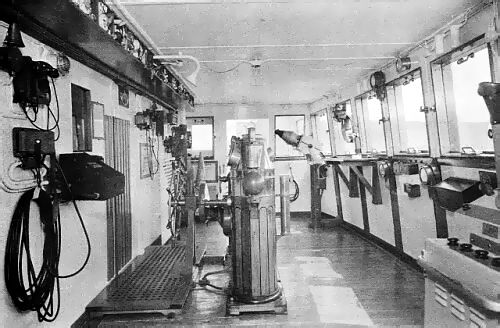
The
Bridge
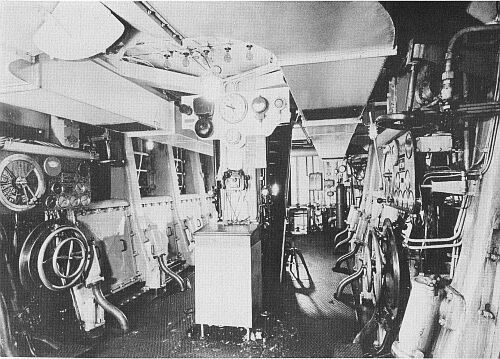
Engine
Room
Although
being a small ship, yet at the time she was the largest ship ever built in Sweden,
yet she remained one of the smallest Trans-Atlantic Liners for a long time due
to her mere 11,650 GRT (Gross Registered Tons). She had a passenger capacity of
just 395, made up of 113 First Class and 282 Tourist Class, although there were
some interchangeable cabins between First and Tourist, and she had a crew of
220.
The Stockholm
did have one very special feature, one that was not found on any ocean liner at
the time, every cabin on board and that included all crew quarters were located
outside. This meant that every cabin on the ship had a porthole or a window and
this was certainly “revolutionary” for the times as crews on other
ships are usually located on a lower deck far forward or aft and they usually
seldom had a porthole!
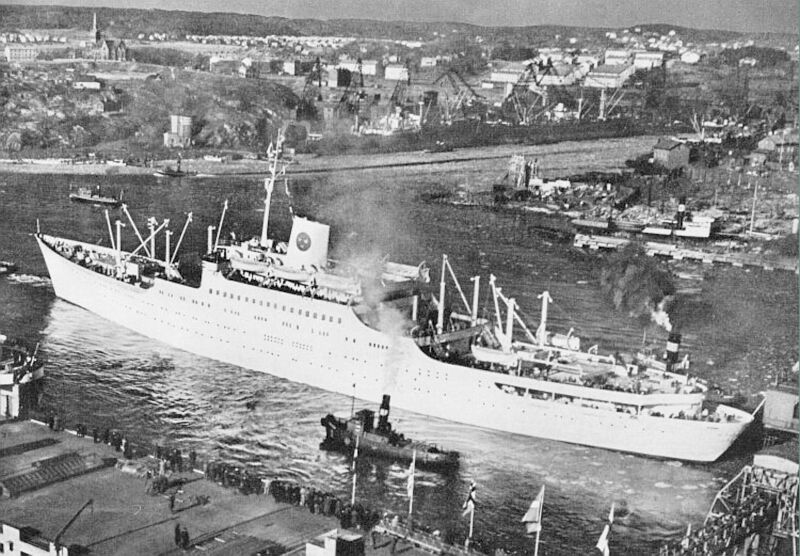
MS
Stockholm departs Gothenburg on her maiden voyage for New
York
On
February 21, 1948 the Stockholm
finally departed Gothenburg on her maiden voyage, which had again been greatly
delayed. Soon passengers found that this rather “yacht-like”
looking ship had one major fault, first, and this was because she did not have
stabilizers and two, her long and slender hull design certainly did not aid her
stability very much! For a small ship departing on her maiden voyage in February
during the Atlantic winter, this was without a doubt the very worst time to
introduce a brand new liner and have her sail on her maiden voyage during the
worst and the roughest of weathers bound for the United
States.
I must say however that the poor Stockholm did
encounter one of the worst possible winter storms imaginable and the movement
of the ship was extremely wild, and as I have been told by one passenger who
was on board that voyage “She pitched and rolled so wildly at times and
then suddenly she would move and heave totally unpredictably the other way as a
huge wave would hit the ship.” Tragically one passenger died during this
storm on the Atlantic.
It seemed that the Stockholm's
ongoing (early) bad luck was following her all the way to America!
When the Stockholm
arrived in New
York, sadly the
American SAL branch did not quite welcome the new ship with open arms, for they
really wanted another bigger and a more grandiose liner, they felt that the Stockholm
did not measure up with the competition! But the question begs, was their
assessment of this ship really correct, or had they in fact under estimated
this attractive looking ship?
Time would tell!
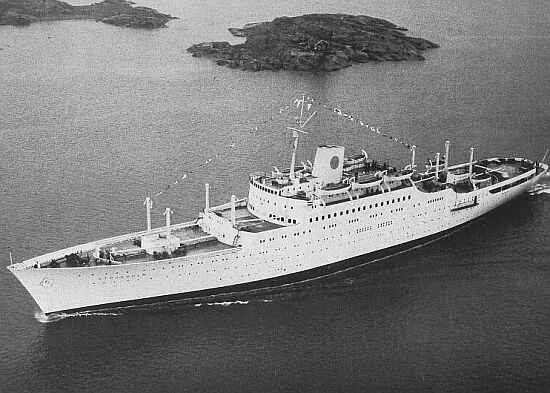
A
superb aerial view of the sleek looking MS Stockholm
After
a few voyages during a terrible 1948 winter, the American’s hailed her as
being “The Worst Roller on the North
Atlantic.”
Finally, it would be in 1956 that Denny Brown stabilizers were fitted to aid her
bad habits!
However, in spite of the USA
management’s misgivings, the Stockholm
did have a great future ahead of her in the American market, one that was far
better than they could have possibly imagined. Financial success was certainly
not to be found on the Atlantic service alone, although she would continue to
operate it on a regular basis, but she was always somewhat of a failure on the Atlantic,
due to the larger and grander competitors. However, she became a huge success
in the calmer waters of the New
York to the Caribbean
cruise market!
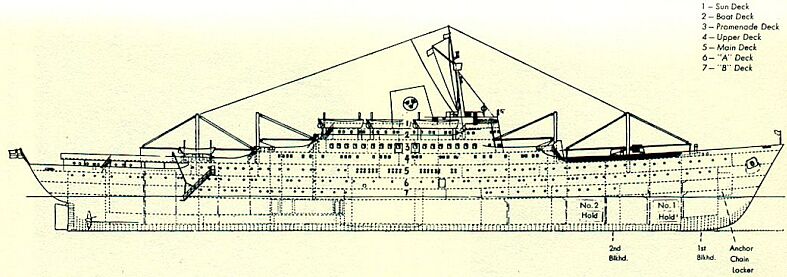
This
is an illustration of the Stockholm
as built in 1948, but her hull section was unaltered after her refits
Thus,
it is obvious, that there was something very special about this delightfully
small and intimate ship, that obviously the American management had completely
missed and they simply could not see the possibilities that she had in her!
Whilst they were so busy thinking about her size and the grandeur of the other
ships, they forgot about that special appeal that the Stockholm had, such as
her beautifully sleek exteriors, for her superb curved bow gave her those long
elegant sleek lines and the American SAL office were surprised that she became
such a sought after cruise ship! The American public simply took to this
yacht-like ship, for one she just looked the part and she was more like an
oversized private yacht and internally she had obviously been built for relaxation
and comfort rather than the usual over the top luxury that suited the needs of
the cruising public perfectly!
Page
Two contains a photo album of her interiors. A link
is located at the bottom of the page.
SAL Orders New Tonnage:
In
the late forties the Swedish America Line realized they were in need of new
tonnage and had their architects lay down plans for a new ship, the 21,141 GRT
MS Kungsholm. The order was placed with the Dutch
Shipyard De Schelde in The Netherlands and she was completed on October 9,
1953. With the success of the Kungsholm SAL decided
to build a slightly larger version in 1954 and ordered the 23,191 GRT MS Gripsholm, to be built by the Italian Ansaldo Shipyards.
She was completed and delivered in April 1957. With the arrival of these two
elegant sleek twin funnelled liners, Swedish America Line had returned to their
old days of operating modern large ships with their famed superior
accommodations and grandiose public venues.
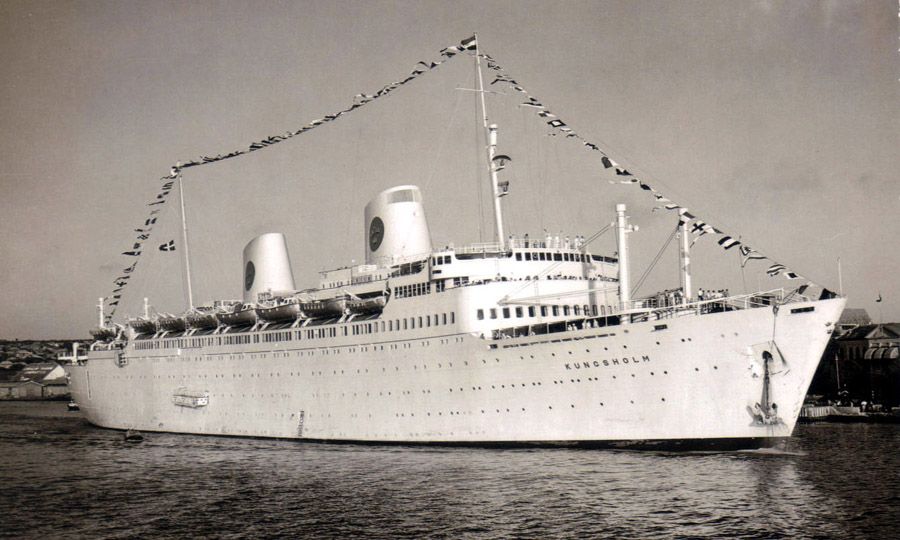
MS
Kungsholm of 1953
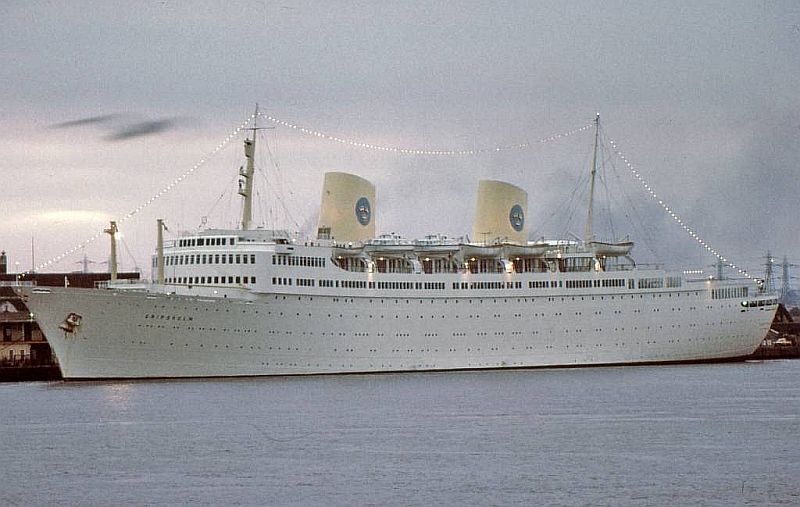
MS
Gripsholm of 1957
Photographer
unknown; *Please read the photo notes at bottom of the page
MS
Stockholm’s 1952 and 1955/56 Rebuilding Programs:
Although
the Stockholm IV may have been the “odd ship” on the Atlantic
for the next five years but she continued to prove to be quite popular as a
cruise ship, thus SAL decided in 1952 to give her a comprehensive refit, which
would include some rebuilding. The ship's superstructure was enlarged to
include additional passenger cabins as well as a small cinema. Upon completion
she accommodated an additional 178 passengers, a total of 568 in 215 cabins.
132 twin bedded cabins, 28 - 3 berth and 55 - 4 berth. Her tonnage was now
registered as being 12,644 GRT.
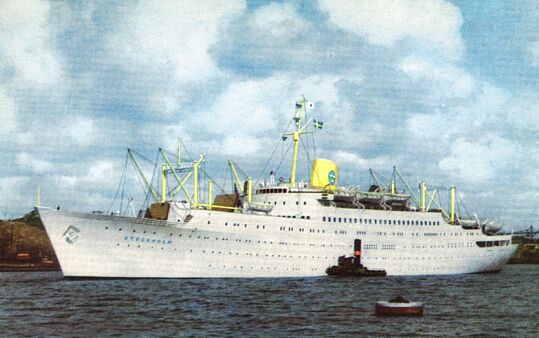
She
is seen here after her 1952/53 renovations and her forward extensions
Then
more importantly, late in 1955 the Stockholm
was sent back to the shipyards where she would finally be fitted with those
all-important Denny Brown Stabilizers, which were to tame her notorious rolling
habits on the Atlantic,
although SAL decided to keep her cruising during the winter months. In
addition, further accommodations were added forward on Promenade deck. The work
was completed early in 1956, the very same year that would place the name of
the Stockholm
in the books of maritime history forever, but sadly not for the best of reasons!
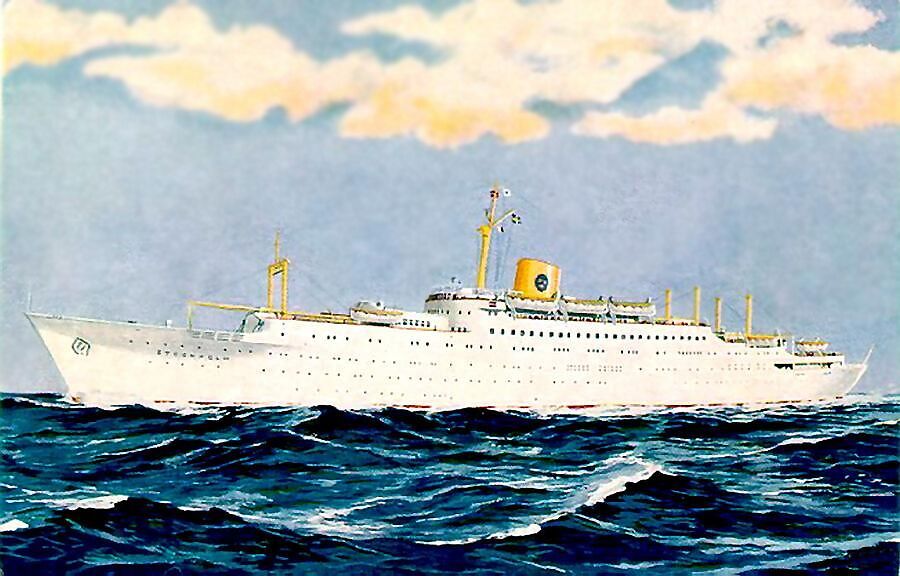
A
postcard made after her 1955/56 renovations showing her new forward upper level
superstructure
The
Collision between MS Stockholm and T/N Andrea Doria:
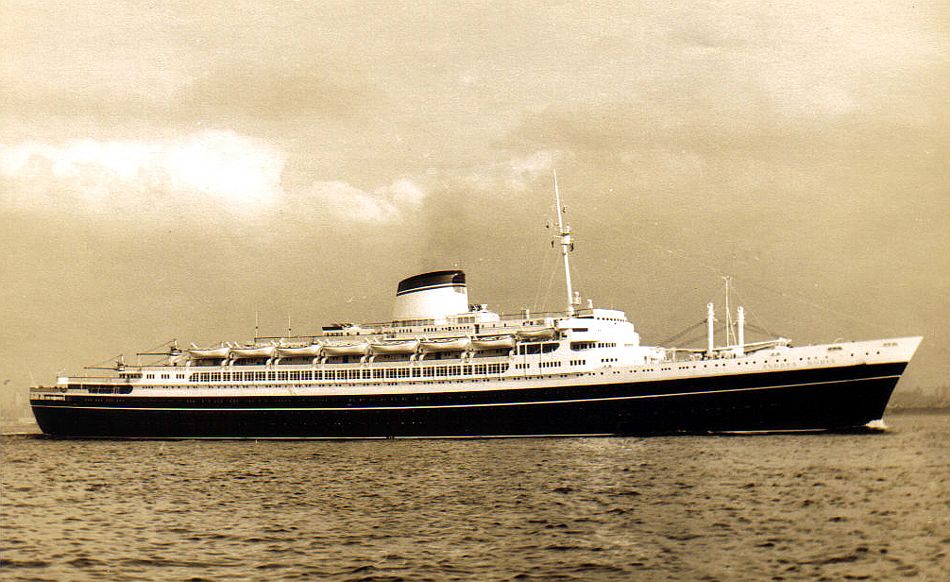
Italia
Lines elegant 29,082 ton T/N (SS) Andrea Doria
TN
Andrea Doria details:
The
stylish Italia Line TS Andrea Doria was built by S.
A. Ansaldo, Genoa
(yard 918) Italy.
She departed on her maiden voyage from Genoa
to New
York
on January 14, 1953. She was the first of a pair of ships, with her sister the
TN Cristoforo Colombo being completed a year later
and it was said that she was by far superior and more luxurious than the Andrea
Doria with her interiors having received a great deal
of attention, whist the Andrea Doria was considered
being more austere in comparison. Andrea
Doria was 213.4 m (700 ft) long and 27.5 m (90.2 ft)
wide, her draught was 14 m (45.9 ft). She had Parsons geared steam turbines,
twin screws, 50,000 SHP and her cruising speed was 23 knots, with a maximum
being 25.5 knots. She accommodated 218 First Class; 320 Cabin Class and 703
Tourist Class. She had a crew of 563.
She was fully air-conditioned and stabilised.
What made this maritime disaster different
from all others is the fact that it was the very first that a well known Trans-Atlantic
liner sinking could be seen on black and white TV throughout the United States
and around the globe as the images slowly spread to counties that had TV in
those early days of television. Thus it was the first major maritime disaster
that was viewed by the masses from the comfort of their lounges and that alone
made it so much more shocking!
Sadly what many were not aware of is that the
Andrea Doria was a ship with a number of problems,
even before she commenced her voyage from Genoa,
for she had developed steering problems. It is clearly stated on record that
Captain Piero Calamai had
requested to postpone the voyage and to place the ship into dry-dock for
repairs, but the company executives demanded that the ship was to depart on
time. This was based due to it being the height of the summer season and the
Andrea Doria was fully booked, thus she had to sail,
if she did not it would have been a financial disaster! Sorry Italia Line, it
was going to be much worse than you ever expected!
She departed with one of the company’s
older ships the 1927 built MS Saturnia, which sailed
close behind her but was nowhere near her when the collision occurred. The
Andrea Doria besides a good number of other problems,
she also suffered from poor stability problems from the day she undertook her
deep sea trails and the combination of her poor stability and steering problems
at the time of the collision obviously proved to be decisive factors and her
eventual sinking, not to forget her watertight doors not being able to work
effectively.
The Collision:
The
MS Stockholm departed New
York on
her 103rd eastbound crossing bound for Gothenburg Sweden
on July 25, 1956 and this was not going to be an ordinary voyage! Her
Captain was Captain Gunnar Nordensson who was one of SAL’s most experienced senior
officers as he had been in the industry since 1911. However on the bridge as
she was sailing out to sea was 3rd.Mate Carsens Johannsen and at the helm
was helmsman Peter Larsen.
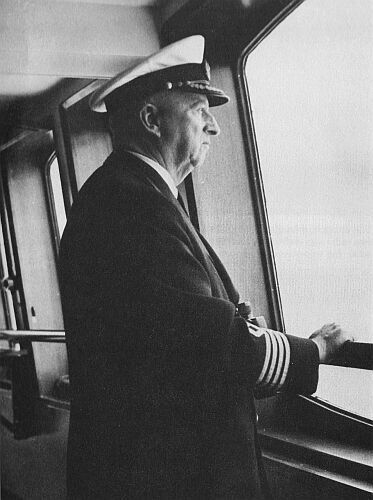
Captain
Gunnar Nordensson
Received
from an unnamed SAL contributor
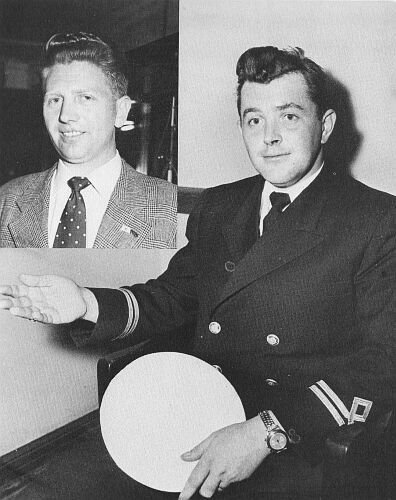
The
main picture shows the 3rd Mate Carsens Johannsen – Inset is helmsman Peter Larsen

Stockholm’s
radar
Due
to a variety of errors, the vast majority being due to an error made by the
master of the Andrea Doria Captain Piero Calamai who made a gave the order to turn to port, when he should have gone
to starboard, according to Maritime Law when it is obvious that there is a ship
close at hand, then at around 11:10 to 11.20 pm, on this foggy night in the
North Atlantic Ocean off the coast of Nantucket, the MS Stockholm and the
Italian liner collided in what was to become one of the most talked about
maritime disasters of the time, considering it was the world’s very first
televised maritime disasters.
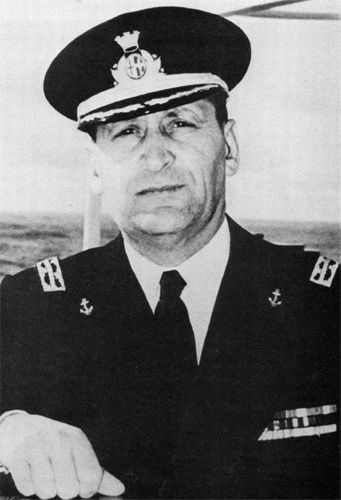
Andrea
Doria’s Captain Piero Calamai
Although
the vast majority of passengers and crew survived the collision, the much
larger Andrea Doria tragically capsized and sank the
next morning. Due to the collision lifeboats on the portside none of these were
unusable. However, other ships in the region rapidly responded and provided
assistance, which averted a large loss of life.
The court case later revealed that experienced
Captain Piero Calamai and
his officers aboard Andrea Doria had certainly used
improper procedures, including the use of their radar. But obviously, the worse
incident was that Captain Calamai ordered that stupid
illegal turn to port (the left) just moments prior to the collision with the
Stockholm, rather than heading to starboard (the right), which is the official
“rule of the road” whenever there is a ship ahead or close by.
The Stockholm knew from their radar that they
were running parallel and that there was no danger whatsoever, until that turn,
and 3rd Mate Carsens Johannsen,
after the collision continually asked, “Why did they turn, why did they
do that,” but, neither his Captain nor anyone answered, for they were all
to busy on the bridge! Carsens went into a daze for
he just could not figure out why anyone could possibly have turned their ship
to port? As the Andrea Doria was still sailing at
full speed ahead at a good 22.5 knots, even though they were in fog, when the
collision occurred they were unable to bring their ship to a full stop for many
miles. As the Stockholm’s bow had pierced the Andrea Doria
the forepeak had simply been torn off, not just because of the piercing, for
she has a double one inch steel ice strengthened hull, but it was torn off by
the speed of the Andrea Doria as she raced ahead.

As can be
seen Stockholm’s
bow was completely sheered off when it had entered into the Andrea Doria
The Miracle Girl:
Although
through all the pain and loss of life there was one rather miraculous case and
this is the story of the girl that became known as the “Miracle
Girl” for good reason! It is the story of 14-year-old Linda Morgan who
was on board the Andrea Doria with her Mother, Mrs.
Jane Cianfarra, who had married for the second time
to Mr. Camille Cianfarra and they had cabin 54 on Upper
Deck. Linda and her sister Joan were in the adjoining cabin next-door number
52. Linda’s birth Father was a Mr. Edward P. Morgan, and Linda was born
in Mexico.
But apparently Jane and Edward separated relatively early and she remarried
some time after to Camille. Linda was also raised in Italy
and Spain,
thus she spoke English, Italian and Spanish.
Apparently when the Stockholm struck the
Andrea Doria, her bow slid just under Linda’s
bed and somehow she was catapulted onto the Foc’sle
of the Stockholm, and she lay just behind a sea breaker that was about 1 ½ ft
high and was the full width of the ship. Although the forward section of the
bow had now gone, she would have been a good 80 ft behind where the peak of the
bow would have been.
Of course no one was on the top, but below
looking for survivors as there were crew quarters in the forward section of the
ship and sadly five crewmembers were lost and others were injured. However, one
thirty six year old Spanish cleaner Bernabe Polanco Garcia, felt he needed some fresh air and went up
out on deck, and far forward, suddenly he heard a girl cry and calling for her
mother. It seemed to come from near the wreckage on the bow section. He got
onto his hands and knees and followed the sound and discovered a girl in yellow
pyjamas. She looked at him and said in Spanish, “Dondé
Está Mamá?” - “Were is she?” He asked amazed at her being there, for
at the time he thought that she must have been one of the Stockholm’s
passengers. It was only after she was taken to the ships doctor and nurse that
it was discovered that she was not on the passenger list and that she was
indeed a miracle having been transferred from one ship to another.
In the meantime, her mother Jane was clinging
to dear life in part of cabin that was still left and rescue attempts were
still underway. Thankfully she was saved, whilst sadly during the early stages
tragically she did hear her husband Camille Cianfarra
sigh his very last breath as he died. In addition Linda’s half sister
Joan also lost her life as her bed was directly in line of the approaching bow,
whereas Linda was simply in the right place, as if by a miracle!
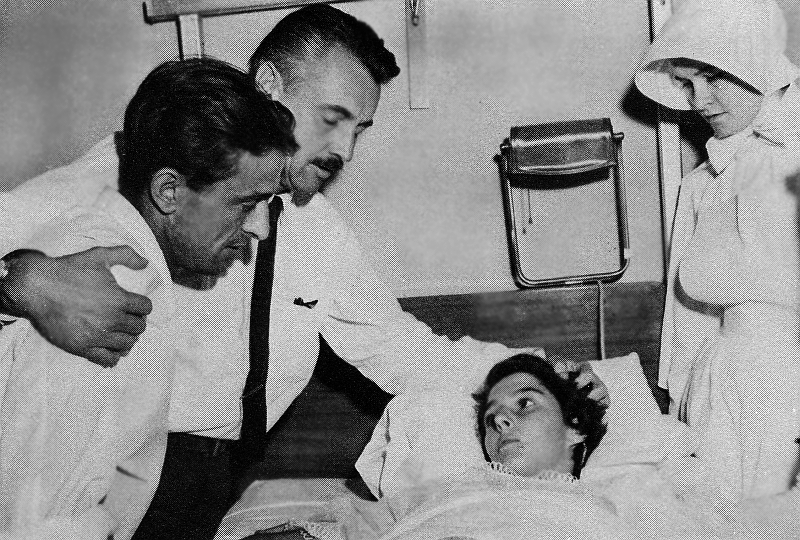
The
“Miracle girl” Linda Morgan in hospital, with her Father Edward P.
Morgan standing on the left is Stockholm’s
Bernabe Garcia the “man from Cadiz”
“New
York Post” archives
Rescue
of Andrea Doria’s Survivors:
Although
the Stockholm was partially crippled for quite some time, due to one of her
anchor cables having gone down and had anchored itself somehow on the sea bed,
but worse still there were three of Stockholm’s crew attached to the
chain and they had been somehow pulled underwater. As soon as they were able to
raise the chain, the Stockholm
went to the rescue and she was indeed the very first ship to arrive and take on
board Andrea Doria’s survivors. The Stockholm
was able to take on board 327 passengers as well as 245 crewmembers.
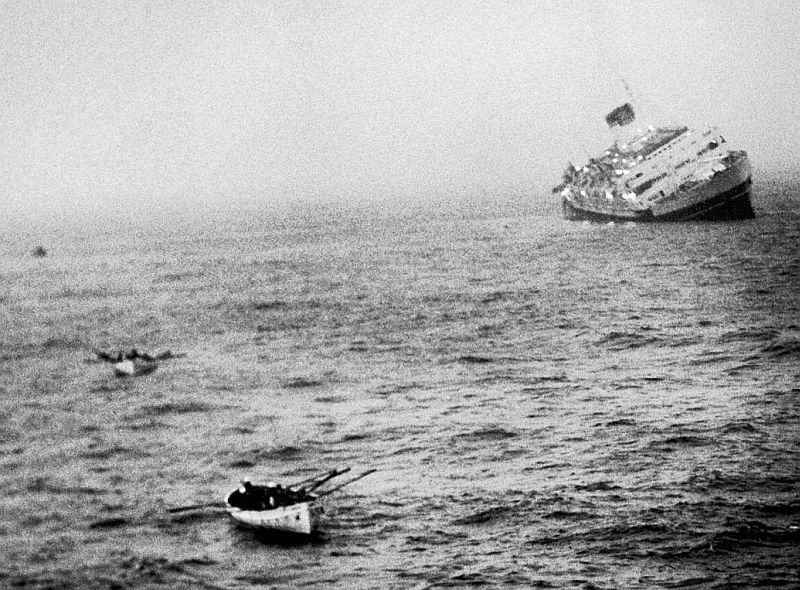
The
Stockholm’s
lifeboats returning with some of the survivors
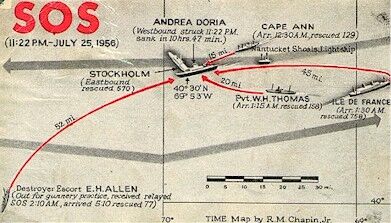
A
map of the collision area and showing the Stockholm
and the three ships that came to the rescue
As
the Andrea Doria had sent out SOS signals, three
ships had responded and were on their way, for no one knew if the Stockholm
would be able to assist in the early hours due to being unable to move.
The first vessel to arrive was the United
Fruit Company freighter Cape Ann which arrived at 12.30 AM taking
aboard 129 survivors, next to arrive was the US Navy transport ship the W.H.
Thomas at 1.15 AM taking aboard 158 survivors and then at 1.30 AM,
the French Lines grand luxury passenger liner the Ile de France arrived
at the scene and she took a 758 survivors on board. The last to arrive was the
Destroyer Escort E.H. Allen arriving at 5.10 AM and took on board
77 survivors; however she received a relayed SOS at 2.10 AM.
As we have already learned, the Stockholm
had taken on board a total of 572 Andrea Doria’s
survivors, which was a large number of additional people for such a small
liner, however, the crew made everyone comfortable and there was ample good
food on board considering her voyage had only just commenced and she was bound
for Europe!
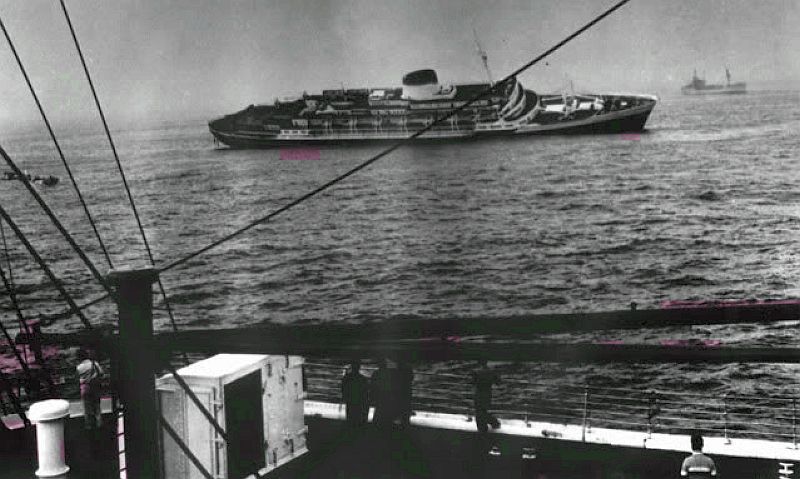
The
Andrea Doria is seen here from the decks of the
French liner Ile de France
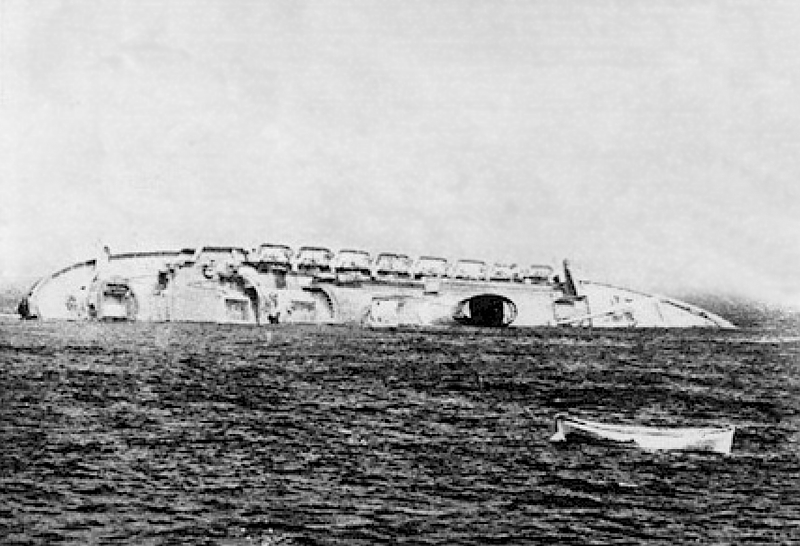
Above
& below: The ship lists to starboard and then
at 1009 hrs on July 26, 1956 the
once magnificent Andrea Doria
Capsizes
to starboard and less than 38 minutes later she
succumbs and sinks bow first to the bottom of the ocean
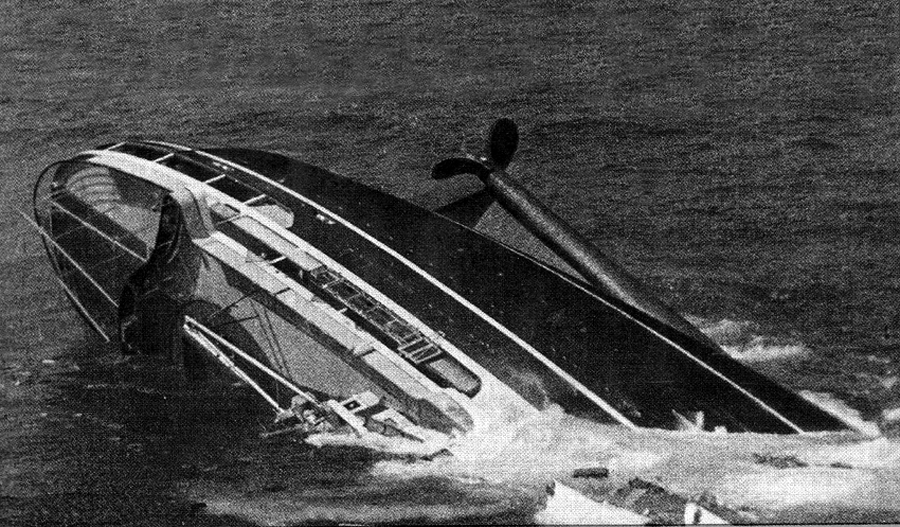
The
TN Andrea Doria perished 10 hours and 47 minutes
after the collision; as here we see the sad moment when Andrea Doria slipped under the waves.
In respect, the Stockholm
remained with the Andrea Doria until she finally
slipped under the waves and went to the bottom of the sea. As she went down the
Stockholm
sounded her horn in respect of the great ship and those that had sadly
perished, then after she had gone out of sight she returned to New
York
under her own power.
Obviously the return voyage meant that there
would be quite some tension for many on board, considering Stockholm’s
badly twisted and crumbled bow, in addition the forward watertight bulkhead was
the only ships only protection keeping the ocean water out of the ship, and
should it give away during the voyage it could turn into yet another disaster.
We need to remember that at this time the Stockholm
was carrying a massive 1,319 people and her lifeboat capacity was for just 846
persons, which was more than sufficient for a fully laden Stockholm
under normal circumstances. But considering the Stockholm being so well built
and an extremely strong ship, she stood up to the massive challenge and she
slowly continued averaging 8.4 knots for her voyage back to New York where
arrived on July 27, being the day after the Andrea Doria
had gone down.
Obviously, many survivors, as well as Captain Piero Calamai had already arrived
a day earlier and made statements to the media and had mostly blamed the Stockholm
as being the ship at fault, thus the shores were lined with people and they
viewing the Stockholm
as being the aggressor. However, as they saw the small sized Stockholm
arrive with her missing bow they were amazed that this very small liner was
still afloat, whilst that so-called great and mighty TN Andrea Doria, being a much larger and newer ship sunk so fast.
They asked themselves “How can such a small ship have done that?”
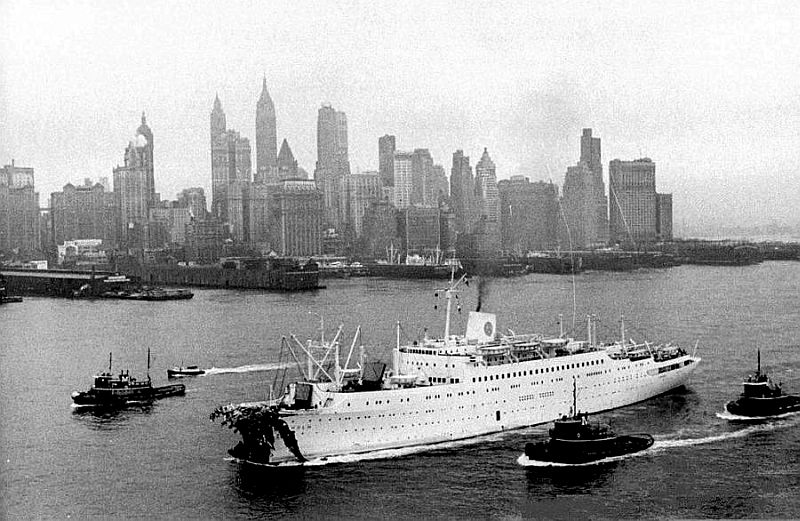
As
the Stockholm
arrived she obviously attracted a large crowd as she looked quite a sight with
her bow sheered off!
Court
Case & Settlement:
At
first Italia Line approached SAL for an out of court settlement, which SAL
obviously rejected, knowing well that the collision was caused due to
negligence by a member of the crew, this case being the Italian Captain
himself. Thus the case went to court.
During the long court case it was revealed
that officers aboard the Andrea Doria had used
improper radar procedures, and that a decision had been made which resulted for
the ship to turn suddenly to port (the left) moments prior to the collision,
rather than to starboard (the right) which would have been protocol, or as it
is known the official maritime law of the “rule of the road” when a
ship is close by and in the circumstances as they were shown on the radar on
board the Andrea Doria at the time! Even though due
to the fog, visibility was poor and it did not help the situation that night,
especially for the Andrea Doria as she was still in
the fog band, whilst the Stockholm
was outside of this band and could not as yet see the Andrea Doria, except on their radar. With Andrea Doria having turned to port the Stockholm
rammed Andrea Doria about amidships on the starboard
side, meaning that the Andrea Doria quickly started
to flood her engine room.
Thus we have seen some of the main reasons how
and why the collision came about, but there were other facts that the enquiry
later revealed, and some of these were as follows;
1, the Andrea Doria departed her homeport with a problem, and this
happened to be as we know with her steering gear. 2, tragically some of
the watertight bulkheads on board Andrea Doria proved
to be non-operational at the time, and thus she flooded rapidly and she sunk
some 10 hours later, which she may not have done had they been fully
operational.
3, however the
enquiry also decided that the Stockholm
also had to take a small measure of responsibility, such as “the non use
of the fog horn,” even though she was not in the fog at the time, but
would enter it in due course. The Andrea Doria was
hidden inside the fog, but the Stockholm
was always aware that the Andrea Doria was there and
that they were running parallel. Thus at the time all was well, whilst both
ships were on their “original heading’s,” I state again, on
their “original heading”, which at the time meant that there was no
emergency whatsoever! That was until Captain Calamai
suddenly and illegally changed his course “to Port” and the tragedy
came about! 4, another mention made in the inquiry’s reports is
that both ships continued at speeds that were considered too fast for the
conditions considering the circumstances. Andrea Doria
was going at full speed of 22.5 knots and the Stockholm
at a slower 18 knots.
Having taken in considerations of all the
facts, the judgment deemed that the Captain of the Andrea Doria,
but in other words Italia Line, would have to take the major share of the
blame, considering the many errors that were made on board that Andrea Doria considering the many other problems the ship had.
Although there were 40 (some state 46) lives
lost from the Italian liner, thankfully the vast majority of passengers and
crew survived the horrid collision.
PS: Most of the
senior crew of the Andrea Doria developed various
problems especially the captain and sadly all vanished into obscurity, whereas
the Swedish captain and his crew were mostly promoted in due course and
continued with successful careers.
Stockholm’s
Bow & Return to service:
Although
Italia Line was to pay for Stockholm’s
bow, the Swedish American Line agreed to cover the $1 million replacement of
the ship’s bow, leaving Italia Line with the cost of a US$30 million loss
for the Andrea Doria and having to deal with the huge
cost regarding human financial issues in Europe and in the Americas!
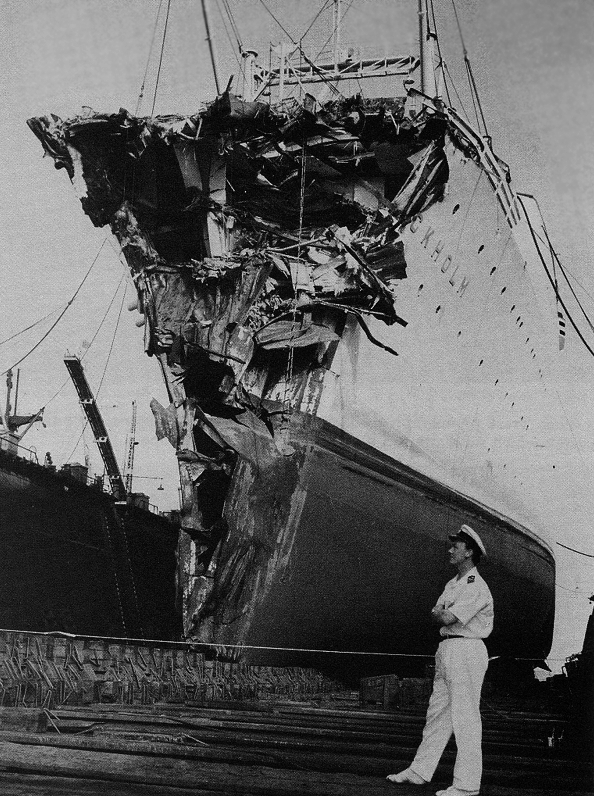
Second
Officer Lars Enestrom takes a good look at the
damaged bow of his ship in dry-dock
Soon
she would be like new again and back at sea!
The
Stockholm’s
bow was completely and superbly repaired at the Bethlehem Steel Company
Shipbuilding Division in Brooklyn New
York
and just over three months later the Stockholm
returned to her duties operating her regular services.

MS
Stockholm is seen here in her final days with additional extensions on her fore
Promenade deck
However,
the Stockholm
somehow remained the “odd ship” of the fleet, for in these new and
more modern days she simply could not offer the same high standards as the
newer and larger and more luxurious MS Gripsholm and Kungsholm. Thus, within two years after returning to
service, in 1959, SAL decided to sell the “odd ship” of the line
and she was placed on the market.
Technical details - MS Stockholm - 1948
to 1959.
Built by: Gotawerken AB
Gothenburg,
Sweden.
Official
Hull
No: 8926.
Ordered
on: October 1944.
Yard: 611.
Launched
& named: September 9, 1946.
Delivered: February 7, 1948.
Maiden
Voyage: February
21, 1948 – Gothenburg / New
York.
IMO
No: 5383304.
Gross
Tonnage: 11,650 GRT / 4,700 DW
– (12,644 GRT / 4,800 DW in 1952).
Length: 160.8m
– 525.2ft.
Breadth: 21.4m
– 69ft.
Draft: 7.9m
– 25.11ft.
Main
Engine: 2 x Gotawerken
diesel engines, 2-stroke/single acting, 8-cylinders.
Total
power of 12.000 BHP (8,900 kW).
In
1989 she received - 2 x 8 Cylinder Wartsila Diesels.
Propellers: 2 X
12,000 BHP.
Speed: 19 knots
max.
Stabilizers: no – (yes 1952).
Decks: Eight.
Passenger
Lifts: Two.
Passenger
Capacity: 113 First Class and 282 Tourist Class (1948).
86
First Class and 584 Tourist Class (1952).
24
First Class and 584 Tourist Class (1956).
Crew: 220
/ 330.
MS
Stockholm Memorabilia:
In
March/April 2011, whilst on a cruise from Australia to England on MV Athena
being the ships then name, which will be covered later in the Stockholm’s
history, I met a delightful couple Mr and Mrs Knutzelius
and Mr. Nils Knutzelius was kind enough to give me a
flip top match packet that came from a voyage undertaken by his mother Mrs. Wilga Knutzelius and her children
Hans (7), Nils (7) and Marianne (2) sailing from Gothenburg to New York in
January 1949. The unusual thing is that this little packet opens at the top -
thus opening somewhat like a V shape - rather than the typical flip over style
lid like of the modern style matches found on ships in days gone and those
still available. I recall that matches used to be real collectors item in days
gone by. Sadly I cannot recall, which of the aforementioned children was the
actual child passenger on board the MS Stockholm, but I am most grateful for
their kind gift!
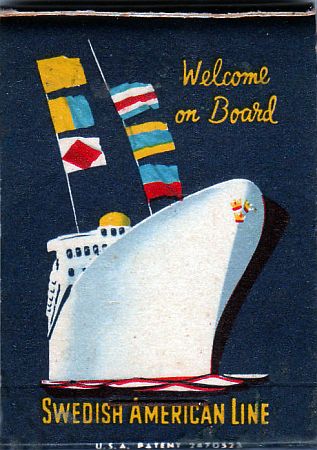
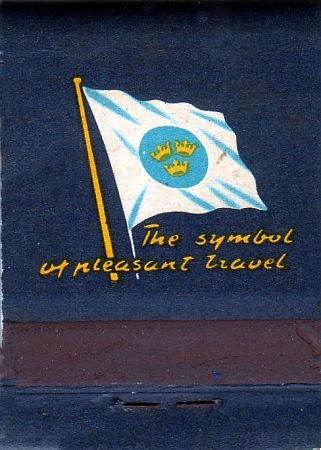
Thank
you to Mr and Mrs Nils Knutzelius for providing this delightful item of memorabilia
Then
during my next cruise to England on the M/V Athena which departed on April 14,
2012, my dear friend and Maitre D’ Hotel, Mr. Nicolae
Arba was so kind as to present me with a most
treasured copy of a “Farewell Dinner” Menu from one of
Stockholm’s voyages dated March 8, 1949, being just over one year after
she commenced her maiden voyage on February 21, 1948.
The cover has a beautiful painting by the
famed Swedish Admiral - J. Hägg, showing the East
Indiaman - “Wasa” sailing outbound from
Gothenburg in 1803. The superb menu is in pristine condition!
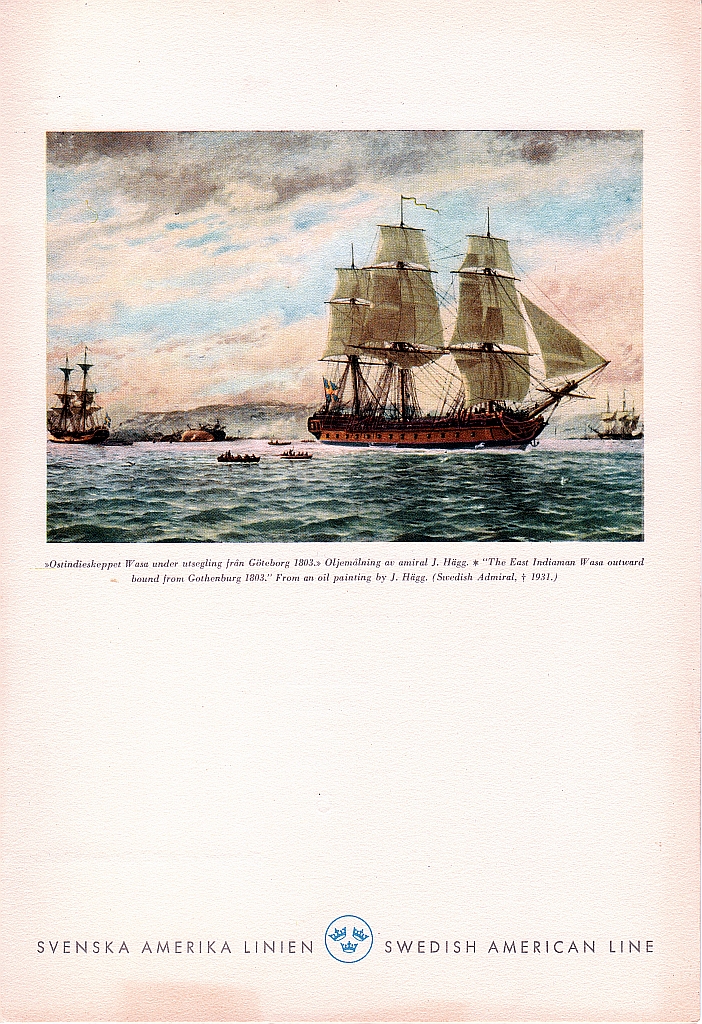
Front
cover of the Menu, which was
kindly given to the author by M/V Athena’s ex Stockholm Maitre D’
Hotel Nicolae Arba
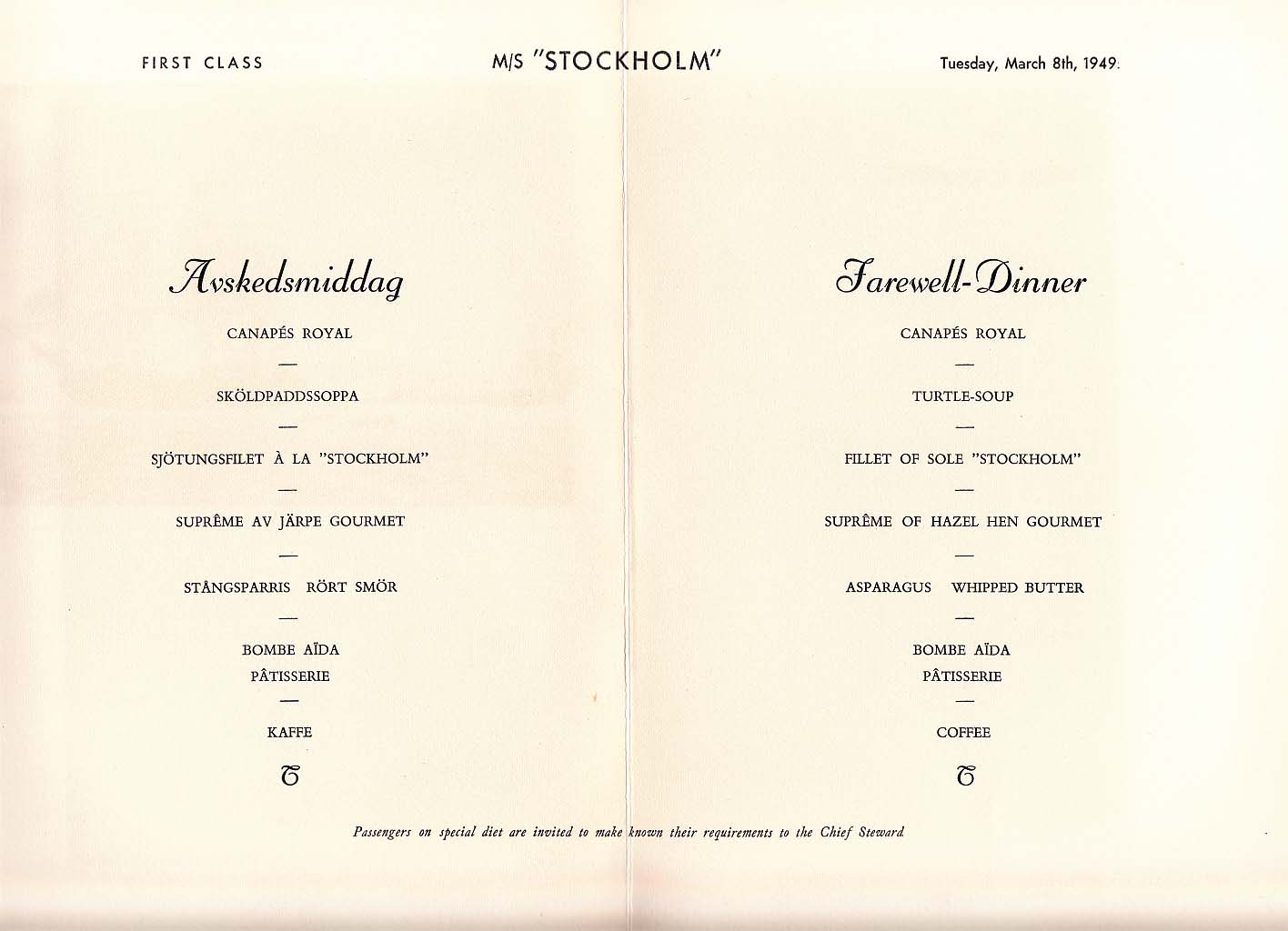
The
interior
of the Menu
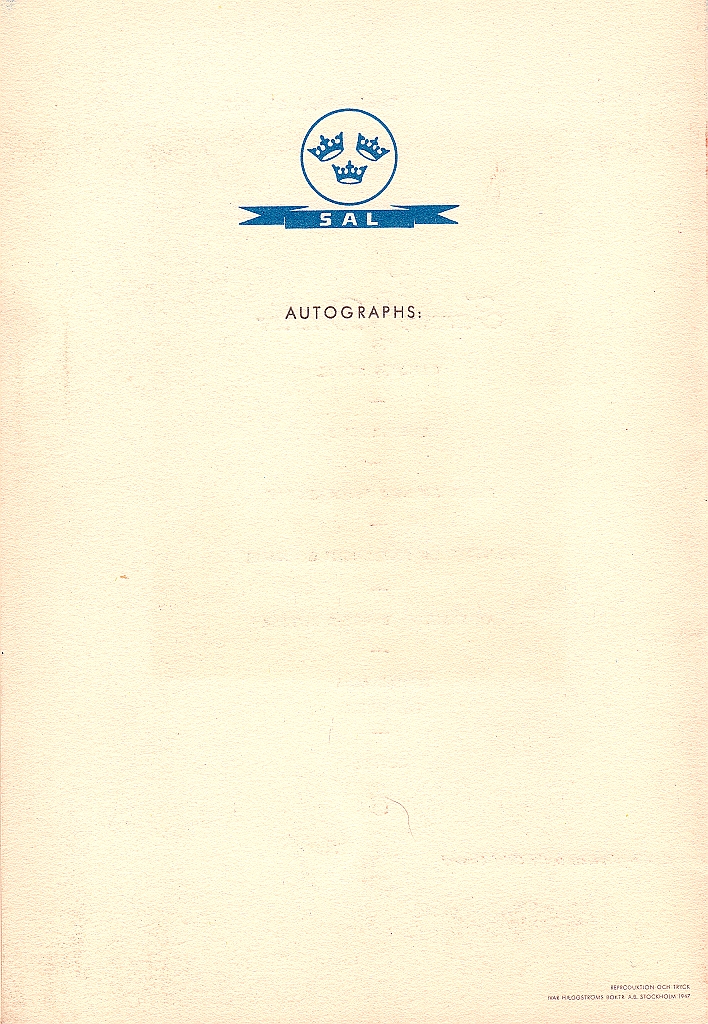
Back
cover with space for Autographs
With
grateful thanks to M/V Athena’s Maitre D’ Hotel Mr. Nicolae Arba
MS
Stockholm Sold in 1959 - MS Völkerfreundschaft:
Having
been placed on the market by SAL and after several failed bids she was
eventually sold on May 15, 1959 to the East German “Freier
Deutscher Gewerkschaftsbund”
being an East German Trade Union Movement Organisation who would place her in
operation as a fulltime cruise ship for workers.
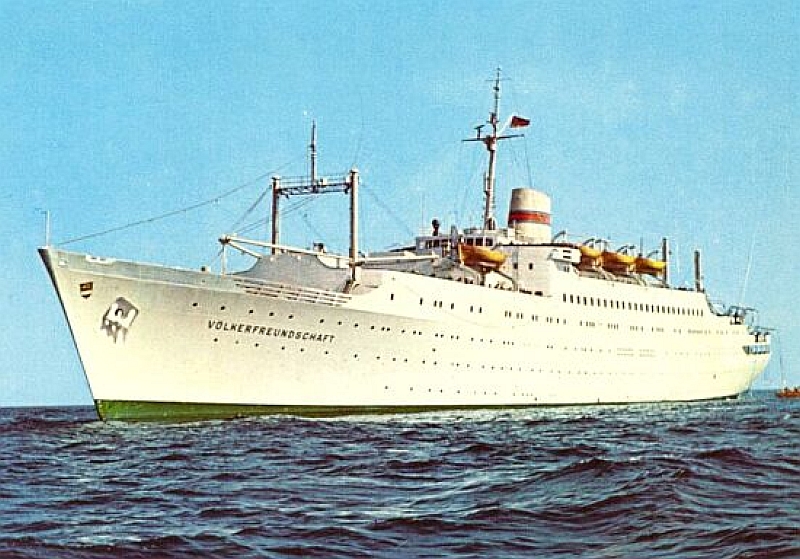
Postcard
of the MS Völkerfreundschaft
After
she received a comprehensive refit she was renamed the MS Völkerfreundschaft
(the Peoples Friend Ship) on January 3, 1960 and she commenced to operate as a
simple down to earth Trade Union Soviet cruise ship and she did so very
successfully. She mainly visited various Eastern bloc countries as well as Cuba
and some western countries as well. She had been placed under the management of
the VEB Deutsche Seerederei of Rostock,
being the port where she was registered.
At times she was chartered by Stena Line who
obtained her at various times from 1966, and thus whilst she was with them the
ex Stockholm
would visit her homeland on a good number of occasions. The
atmosphere on board the Völkerfreundschaft was very
homely and she had that friendly environment as the photographs on the photo
page will prove.
During her time with the Soviets she had a
relatively uneventful life under Communist control, however occasionally she
would hit the headlines in Western newspapers after some of her crew and even
passengers jumped ship in a bid to avoid to returning their
“beloved” free state,
that Communist Paradise known as East
Germany.
In 1974 the Völkerfreundschaft
was transferred to the management of VEB Deutfracht-Seerederei.
Stena Line even undertook a special charter as they took the Völkerfreundschaft on a 33-day Caribbean cruise from Sweden
in mid winter taking Swedes away from the icy cold to the warmer and more
exotic places. However by 1984 her owners had finally decided that they could
no longer cover the mounting losses, and with the ship having been placed on
the market and sold in 1985.
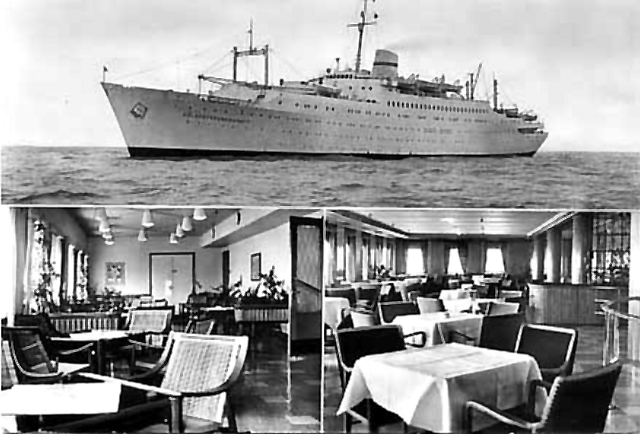
Original
postcard of the MS Völkerfreundschaft
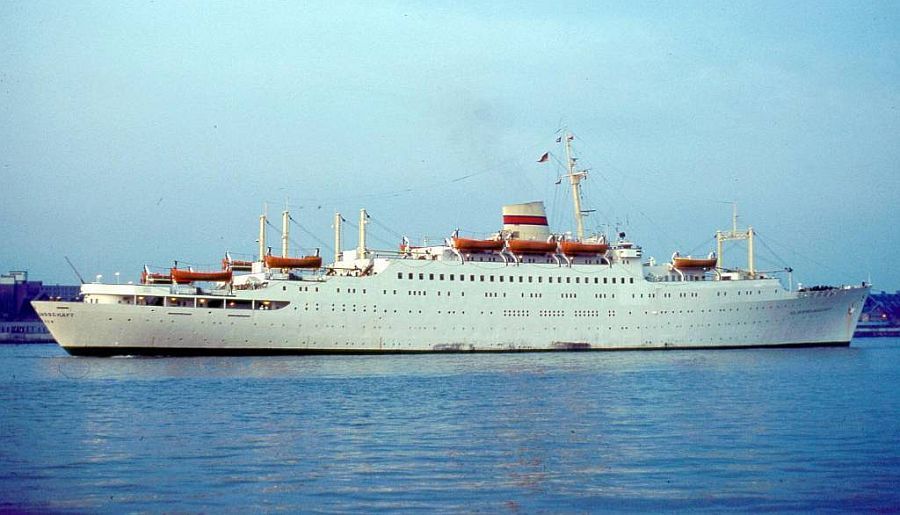
MS
Völkerfreundschaft seen towards the end of her career
Volker
- Fridtjof
Nansen - 1985
- 1993:
On
April 1985 she was sold to “Neptunus Rex
Enterprises” and her name was shortened to Volker (People) and she was
laid up at Holmestrand until December 8 when she
sailed for Southampton
arriving on December 11. 1985. Although certain plans were originally in hand
for her, but these fell through and she was laid up in Southampton
where she remained for a good year.
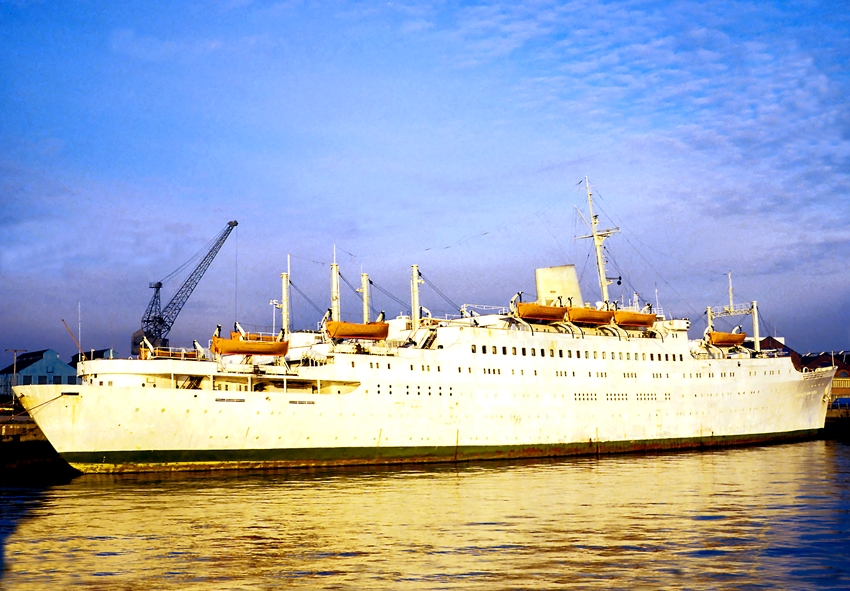
Here
we see the MS Voker in Southampton
sometime in 1986
Photographer
unknown: *Please read the photo notes at bottom of the page
Finally in December the next year
the Volker which had been chartered by Norwegian interests to become an
accommodation ship for refugees and she was renamed Fridtjof
Nansen. She was made ready and on December 20, 1986 she departed Southampton
undertow for Oslo.
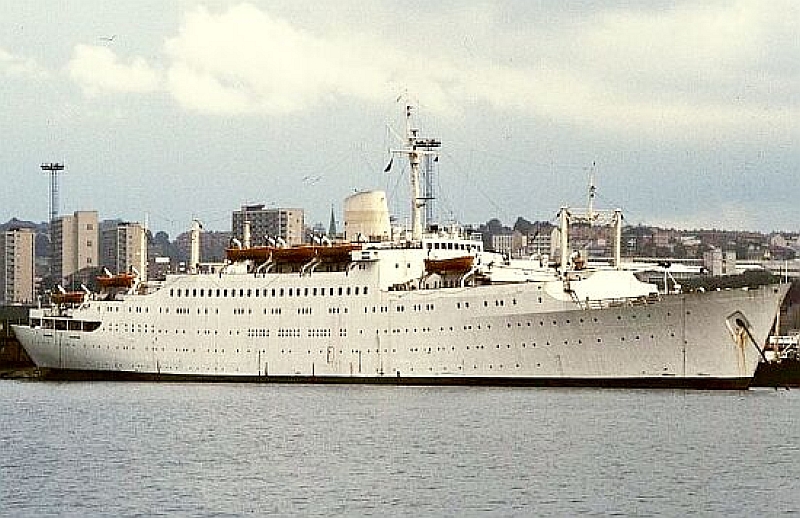
Above & two
images below: The Fridtjof Nansen is seen here as a
refugee accommodation ship
Photograph
above was taken by & © Hans Jurgen
Amberg
Two
images below: Photographer unknown: *Please read
the photo notes at bottom of the page
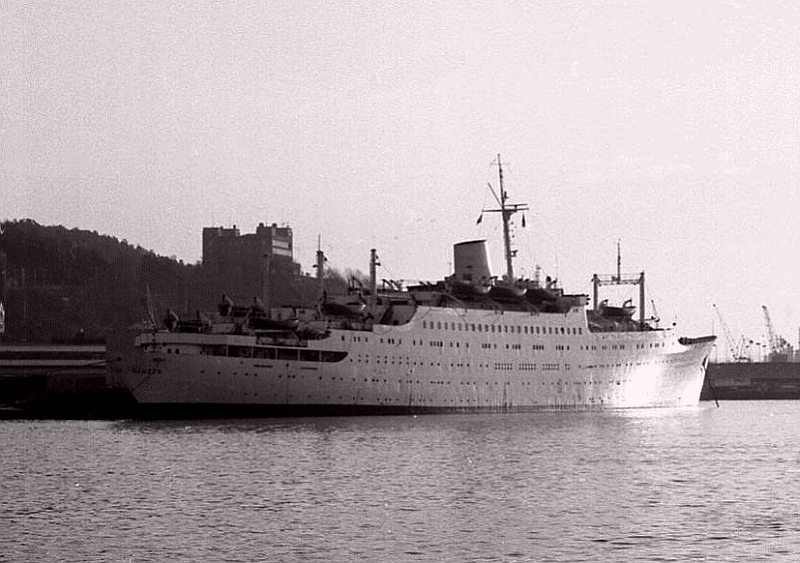
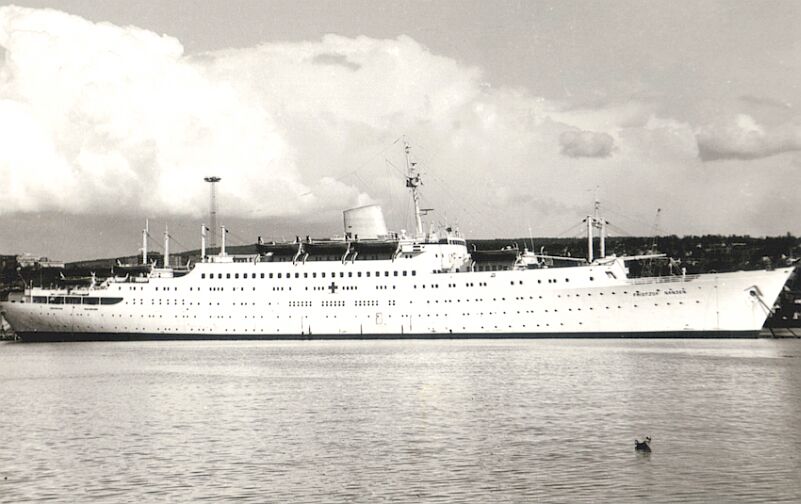
Italia I 1993/94 - Italia Prima
– 1994-98:
Four
years later, May 1989, she was officially sold to the famed Italian Star Lauro
Lines (ex Flotta Lauro Lines) who were going to refit this unique liner into a
luxury cruise ship, but considering she was still under charter until 1993 as the Fridtjof Nansen they decided to leave
her in Oslo. She was
towed to Genoa,
which just happened to be the homeport of the TN Andrea Doria
and Italians called the ex Stockholm
“La Nave Della Morte”
or the “Ship of Death”. Star Lauro very quickly renamed her MV Italia I, which made her
respectable again, now being a true Italian ship!
By 1994 she had already been renamed MV Italia
Prima and it had been decided to completely rebuild her by striping her down to
her magnificent solid steel riveted ice strengthened hull and they rebuilt her
into an elegant looking luxury cruise ship! Thus, only the Stockholm’s
superbly built steel hull remained, for even the hull’s internals were
completely rebuilt with new more spacious cabins, etc.
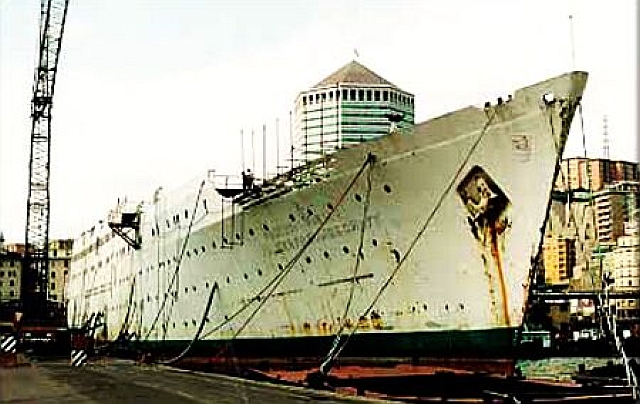
Here
we see the ship stripped down to her hull
Photographer
unknown: *Please see the photo notes at bottom of the the
page
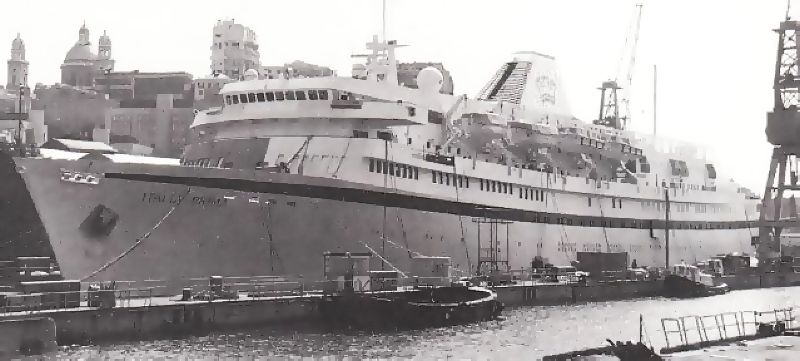
Italia
Prima seen in Genoa
in August 1994, and she is seen here close to completion
From
an Italian newspaper clipping
Italia Prima
was also fitted with new diesel engines and a brand new streamlined
superstructure including a modern stylised funnel with her famous Crown logo.
She was blessed with a fine range of elegant
and spacious, as well as more intimate public rooms. She featured some superb
décor with a great deal of Italian marble, art and touches of brass and chrome.
In her delightful larger lounges located toward the aft with a long curved bar
on the starboard side, there is a superb small Atrium feature that goes down one
floor to the Main Lobby. In the centre is a superb blue to white staggered
glass column that is lit from within, with two curved staircases on either side
a huge mirrored backdrop and other feature that makes this one of the highlight
features of the ship! The décor on board was especially designed by the famed
Italian interior designer Giuseppe de Jorio.
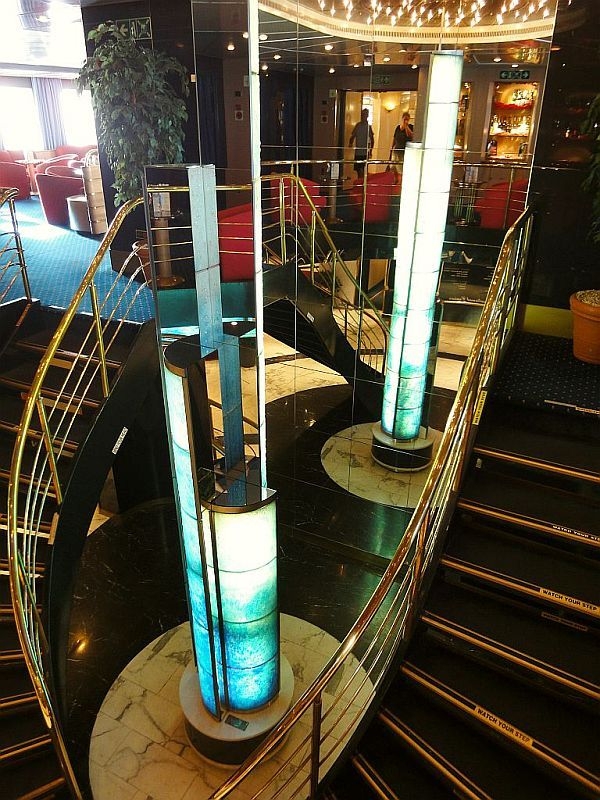
The
Sirenes Bar and Piano Lounge on MV Athena seen in
2011, but it is much the same as it was in 1995
Photograph
© by the Author
Her
accommodations are all excellent and spacious. But amazingly this ship features
some of the most spacious bathrooms you will find on almost any cruise ship
these days. For every single cabin on board has a full bath with an overhead
shower, the floor and basin tops are covered in beautiful Italian marble, and
each bathroom, no matter the grade even has a bidet! All Suites, Junior Suites
or Veranda Suites also have a Spa bath as well as many other extras.
Although the Italia Prima now looked like a
modern cruise ship, somehow she still retained those beautiful classic lines of
the Stockholm’s
superb hull, although a large “Duck Tail” (sponsoon)
had been added to her stern, which runs along the aft of the ship. This feature
is an aid to her stability but it also it assists her speed and fuel economy
and having sailed on her on two occasions, for a total of 80 nights, I can
testify she sails wonderfully, and she is certainly not the “roller”
like she used to be, before 1956 when she was finally given those much needed
“Denny Brown” Stabilizers! Obviously her new owner Star Lauro was
well aware of her earlier sea faring capabilities from her logs. Thus the
“Duck Tail” was especially designed for her.
The cost for this mammoth rebuilding programme cost her owners well over US$150
million, which at the time was a massive amount, but the end result was
worthwhile!
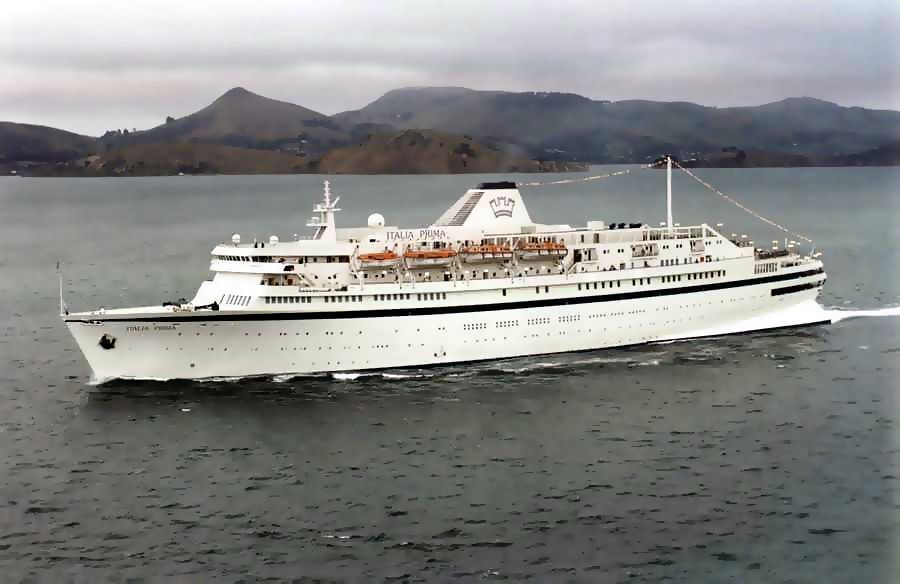
A
wonderful view of the beautiful MV Italia
Prima at sea
The
completed Italia Prima
was placed under the management of Nina Cia.
di Navigazione who managed
her from 1995 to 2002, including chartering her out to various other travel and
cruise companies.
Cruise Editor Mark H. Goldberg from
TravelPage.com said in a review regarding the Italia Prima after her
completion. “Nina Cruises transformed the ex Stockholm
of 1948 into the Italia Prima, a very modern looking ship, yet somehow still a
classic one, but she is as splendid as a swan as ever rode the waters!”
Personally I felt that he said this perfectly
for this Maritime historian, who has been in passenger shipping since 1960, I
believe that this is truly a unique ship that deserves to sail on and she
remains a “swan riding the waters” even in 2012!!
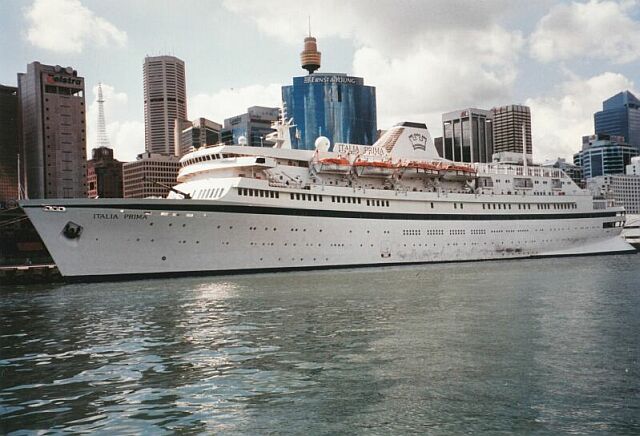
MV
Italia Prima seen in Sydney
in 1997 whilst on a world voyage
Note
the largest “Duck Tail” ever fitted to the stern of a ship!
Photograph
© Reuben Goossens
In
the mid 1997 the now 16,144 ton Italia Prima conducted her first around the
world voyage for the German travel company Neckermann
Seereisen, which included inaugural visits to Australian
ports including Sydney. Thankfully, the author was invited on board for a tour
and to have a delicious luncheon. I found her facilities to be a delight as
were her excellent public rooms and the accommodations were modern and superbly
equipped. In those days she was rated as a 4.5 Star luxury cruise ship. Italia
Prima was a popular ship and was frequently under charter for the luxury German
market, including Neckermann Seereisen
was extremely fussy and always demanded the very best, and they continually
operated a fleet of luxury ships for a very demanding German market!
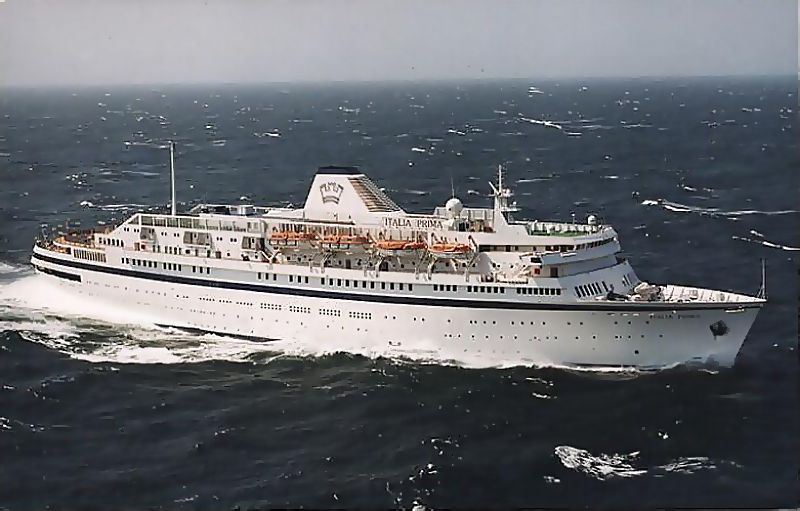
A
postcard obtained by the author whilst on board MV Italia Prima in Sydney
– 1997
Italia Prima Memorabilia:
The
following two items, a plate and an ashtray were all on board the original MV
Italia Prima; however it was remarkably how they have survived for so long, and
they are still used on board the ship to this very day. I found them again on
the MV Athena and I assume that
they will be on board the current “Cruise & Maritime Voyages”
MV Astoria as well, for the ship is still owned by the Nina Group, now known as
“Nina S.p.A.” These items were made by “RADIF”
Porcelain in Genoa
Italy.
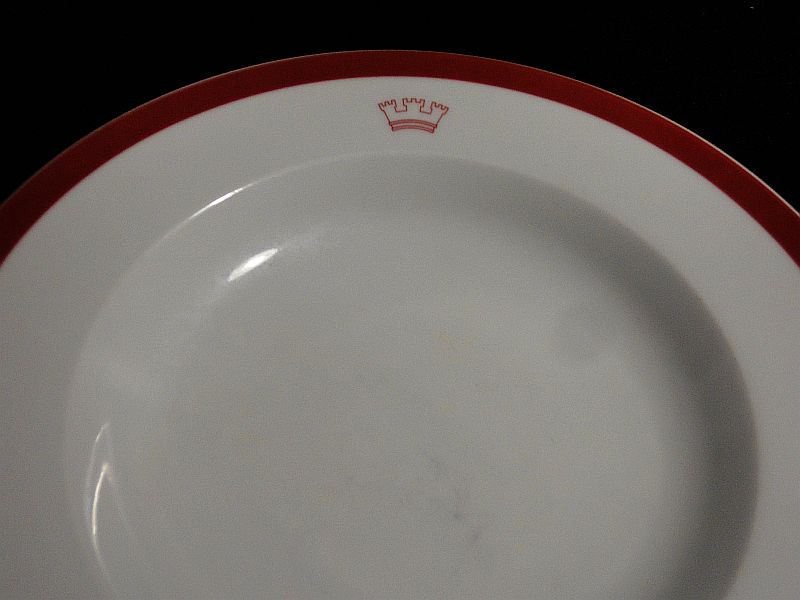
Above
and below: the plate and ashtray were photographed
by the author whilst on MV Italia Prima in April-May 1997
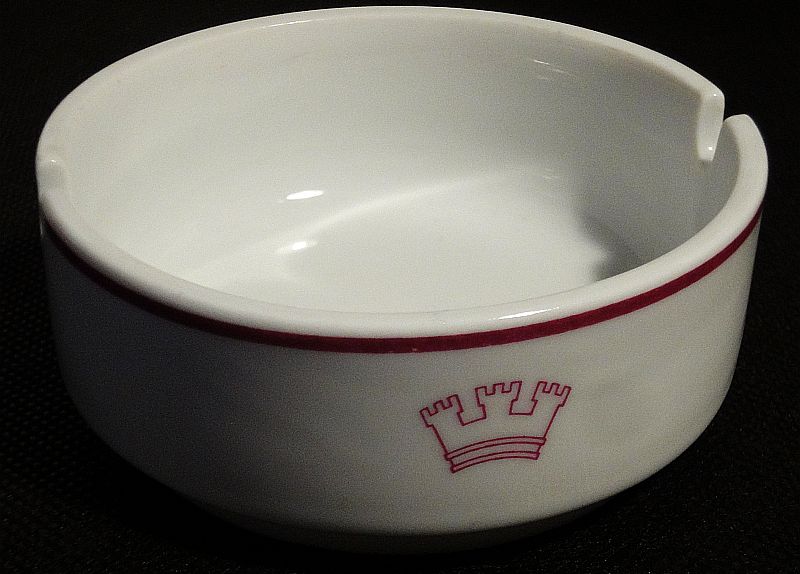
MV
Valtur Prima - 1998 to 2002:
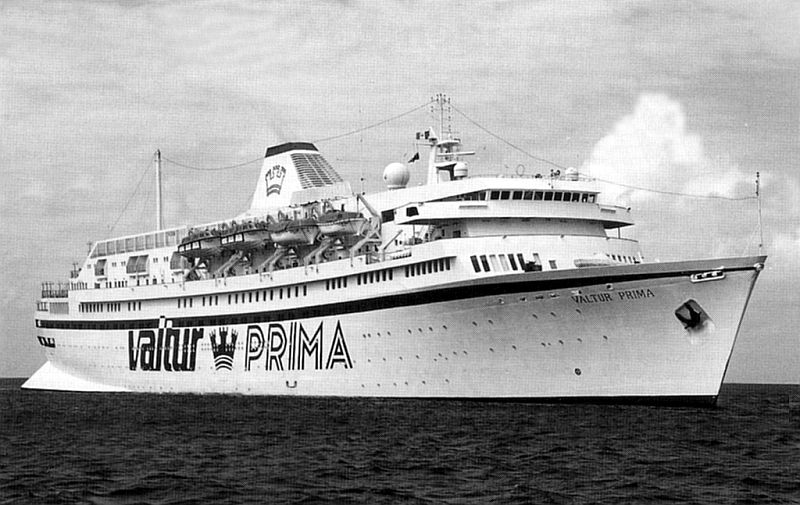
MV Valtur Prima
A
Vultur
Prima publicity image
In
1998 the Italia Prima was chartered to Valtur Tourist
Organization and for this charter she was renamed MV Valtur
Prima with her name placed all over her hull, however this operation was a
relatively short lived as it concluded in 2001 when she was laid up in Cuba
until 2002.
MV Caribe - 2002
to 2004:

MV
Caribe
In
2002 Festival Cruise Line purchased the ship and renamed her Caribe she operated voyages to Cuba.
However, with Festival Cruises had already been struggling financially and the Caribe also struggled to gain popularity for the company
and somehow she proved to be unpopular either in the service they had placed
her on or with the public.
In 2004 she was finally laid up again and things were not looking good for this
neglected looking ship.
MV Athena - 2005 to 2012/13:
The
ship was once again obtained by her original Italian owners Nina Cia. di Navigazione on
January 17, 2005 who renamed her Athena and she was quickly chartered by the
famed Portuguese, Arcalia Shipping who placed her in their Classic
International Cruises (CIC) fleet. Having given her an extensive refit the MV
Athena entered service with the company. She rapidly became a success, and
considering she was doing so well in Europe, in the near future there was
another venture ahead for her with the CIC world of cruising that would once
again see her back in Australia!
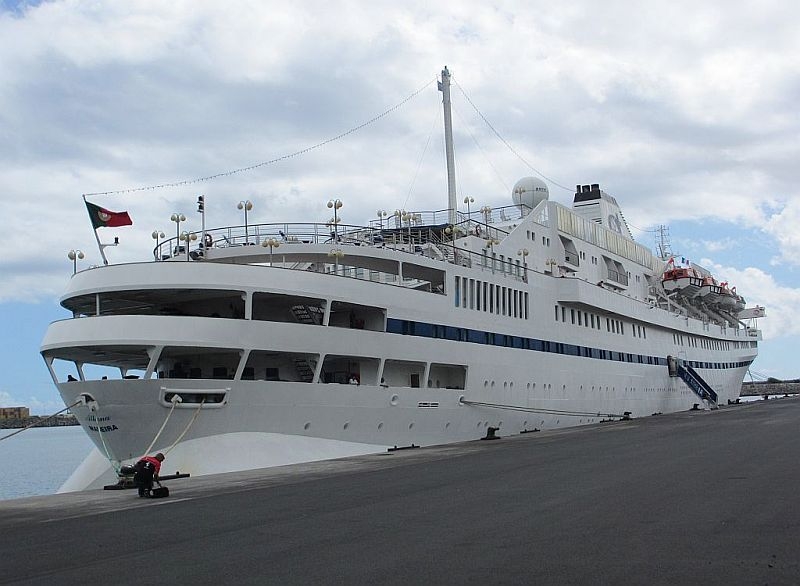
The
Athena is seen at French Reunion on April 24, 2012
Photograph
© by my ssmaritime associate Mr. Hun-Eng Tan
In 2008 she was
purchased outright by the company and was registered in Madeira
and flies the Portuguese flag, and continues to sail under the banner of
Classic International Cruises. She spends most of the year
cruising in and around UK/Europe for CIC with European ports and the Mediterranean
always being popular. In addition being such a popular ship, she also operates
a good number of charter cruises for well known companies such as Page &
Moy Cruises, now Shearing’s and other well known operators, be they
Scandinavian, German or French.
Australian
Cruises:
The
Athena was a popular ship whilst she sailed out of Western Australia’s
port of Fremantle (Perth) and I sailed on her from Fremantle Western Australia
to Portsmouth England via the Suez Canal on March 6, 2011 and again via South
Africa on April 14, 2012 I have written an extensive six page review that
includes countless photographs of all her facilities and accommodations. A link
is found below.
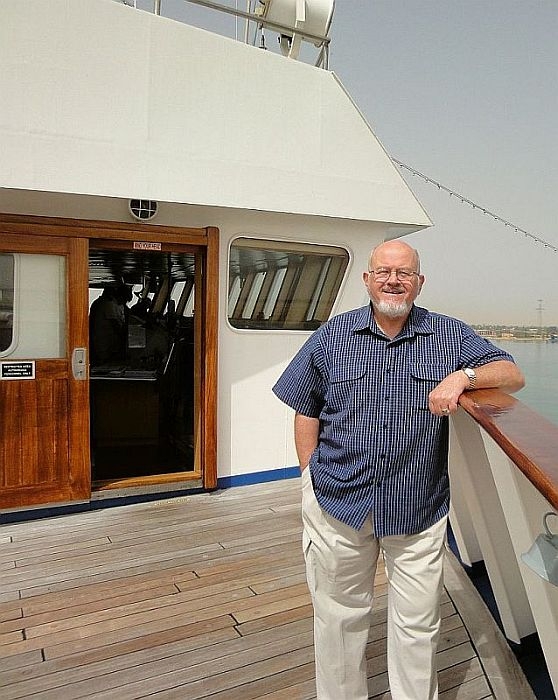
The
Author on the starboard wing of the Bridge
of MV Athena
Photograph
© by my ssmaritime associate Mr. Hun-Eng Tan

The
classic liner, now the modern M/V Athena seen berthed
at Phuket Thailand
on March 15, 2011
Photograph
by & © 2011 Reuben Goossens
MV
Athena’s previous owner CIC due to the much loved and admired CEO and
founder (1975) having sadly passed away in May of 2012 and his twin sons having
taken over the company, sadly the company went into ruin very quickly and into
liquidation by the end of the year with all the company ships arrested.
Portuscale Cruises MS Azores 2013 - 2015:
The Athena was sold
at auction and Portuscale Cruises of Lisbon obtained her early in 2013 and she
was renamed the Azores, but she remained in layup for a long time, for the
company had also obtained the Portuguese 1960 built ship the MS Funchal, and
she was the first to be completely refitted and modified and she commenced
cruising in December 2013. The Athena had been renamed the Azores, a ship I
sailed on for 81 days on two cruises, she received a minor
refurbishment and commenced cruising, under a charter agreement by the German
“AMBIENTE Kreuzfahrten” and she commenced
with them on March 10, 2014.
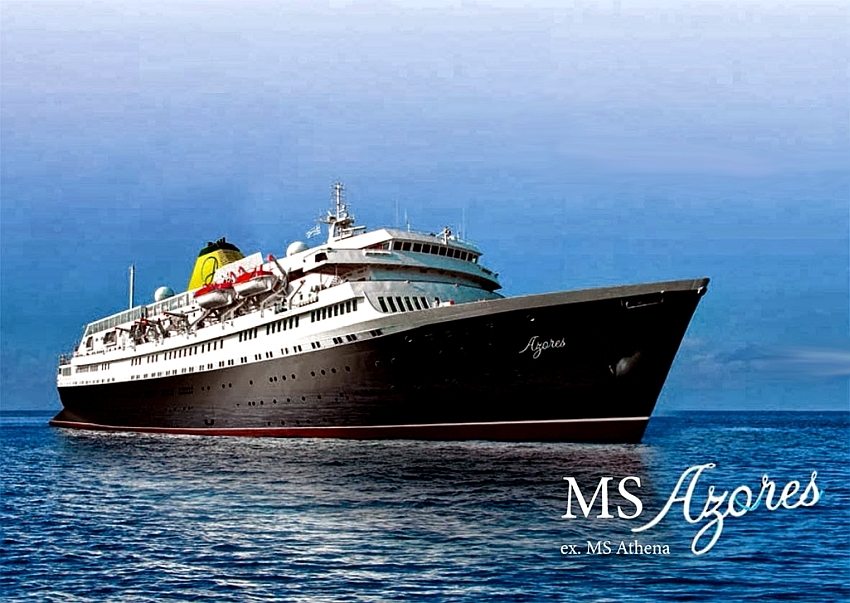
Here we
see the MS Azores in her new livery
A
Portuscale Cruises promotion Image
However, the MV
Azores operated for just until the end of 2015 as Portuscale was a hotel &
resort based company and had little to no shipping experience, and the made
countless errors, thus by the end of 2015 their ships were laid up and placed
on the market.
Cruise & Maritime Voyages – CMV MV Astoria 2016 - 2020:
The ship was obtained by the parent company of
the very popular British “Cruise & Maritime Voyages” and they
renamed her the “Astoria,: and she commenced operation after another
refit out of Britain in 2016 and is sailing until this very day, and the
magnificent Astoria is scheduled for operations until, her final cruise with
CMV in October 18, 2020, being a 13 night “Norway & Land of the
Northern Lights Cruise.” She has been operational for an amazing 72 years
after having commenced her Maiden Voyage as the MS Stockholm!
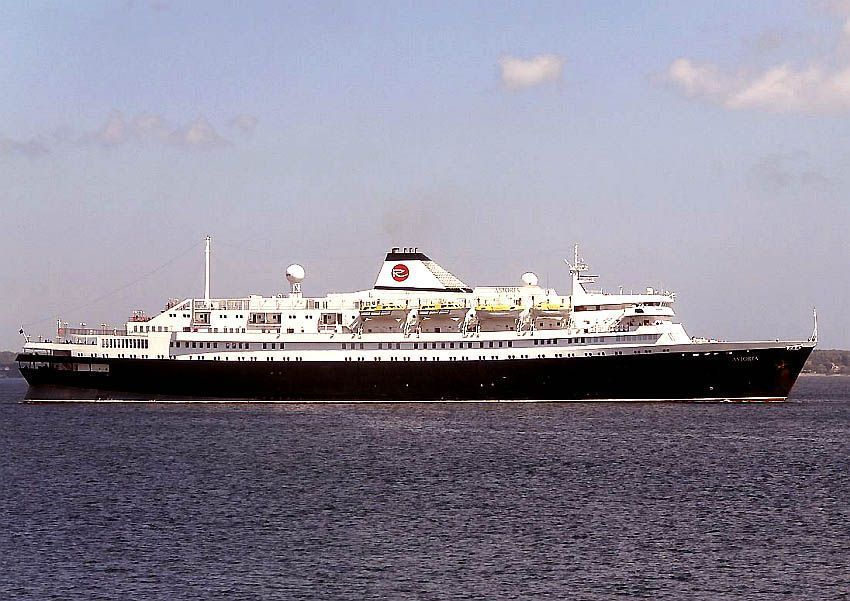
Here we
see the simply sublimely beautiful MV Astoria a ship with an amazing history
yet she remains one of the best
maintained ship on the Seven Seas!
Publicity
photograph
This page has covered the MS Stockholm
history, as well as part of her transformation into an amazing luxury cruise ship,
and her later incarnations. The next Page is a Photo Page, which I am sure you
will enjoy!
Page
Two PHOTO PAGE
PLEASE
NOTE: This photo
page covers the interiors and exteriors of the three stages of this fine ship
…
MS
Stockholm – MV Völkerfreundschaft with a Deck Plan – Also,
after her rebuilding as a cruise ship when she became the MV Italia Prima &
Athena
Read
the Authors …
2012
M/V Athena Cruise Review
***********************************
Use
the Back button on your browser or Close the Page to return to the previous
page
or go to our INDEX
***********************************
ENTER OUR ssMaritime MAIN INDEX
Featuring over 1,350 Classic
Passenger Liners, Passenger-Cargo Liners & Cruise Ships!
Classic Liner enthusiasts visit …
ssMaritime.com & ssMaritime.net
Where the ships of the past
make history & the
1914 built MV Doulos Story
Photographs on ssmaritime.com & .net are: 1. By the author.
2. From the
author’s private collection. 3. As provided by Shipping Companies and
their Publicity Companies as well as by private photographers or collectors.
Credit is given to all contributors. However, there are some photographs
provided without details regarding the photographer concerned., therefore I
hereby invite if owners of those images to be so kind and make them-selves
known to me, in order that due credit may be given!
This notice covers all pages, although, I have done my best to ensure that all
photographs are duly credited and that this notice is displayed on each page,
that is, when a page is updated!
Cruise-Australia is owned/operated and © Copyright by
Reuben Goossens - All Rights Reserved






























































